Hardware
GIGABYTE GeForce GTX 1080 XTREME Gaming 8GB GPU Review

This is our full Gigabyte GeForce GTX 1080 Xtreme Gaming GPU review.
If there is one thing all PC enthusiasts crave, it’s more performance.
There are few GPUs that perform as well as the GP104 GPU on the GTX 1080.
However, the GPU’s actual performance is based on its cooling solution, of which there are many ways to go.
If you’re like me, you tend to not water cool your cards.
However, this makes choosing a card a bit more involved than “Get a reference card and throw a block on it.”
Gigabyte GeForce GTX 1080 Xtreme Gaming GPU Review
When choosing a graphics card, there are several things to consider.
Aesthetics is one of the main things, as well as clock speeds, performance, and noise, to name a few.
However, one of the main things to consider is the cooler. For better performance, you need proper cooling.
For proper cooling, you need a proper cooling solution.
GIGABYTE understands this very well. The proof is in their 2 ½ slot, monster of a card, the GIGABYTE Extreme Gaming 1080.
But is this just another pretty 1080 in a sea of graphics cards that perform well, but are no different than other 1080s on the market, or does the Extreme Gaming 1080 from GIGABYTE stand out from all the rest?
Let’s see how this card stands up to the competition.
A Few Words About GIGABYTE
GIGABYTE Technology is a well-known and respected international manufacturer and distributor of some of the best computer hardware money can buy.
GIGABYTE was established in 1986 by Pei-Cheng Yeh. To date, GIGABYTE holds more than 13, 500 awards and has broken several World Overclocking records with their SOC Force line of motherboards.
On average, they sell over 17 million motherboards alone each year. They design graphics cards and motherboards for both AMD and Intel, as well as much more.
They also design and distribute desktop computers, tablet computers, Ultrabooks, server motherboards, server racks, networking equipment, mice, keyboards, cooling components, power supplies, computer cases, and much more.
Let’s Take a Look at Pascale’s Architecture
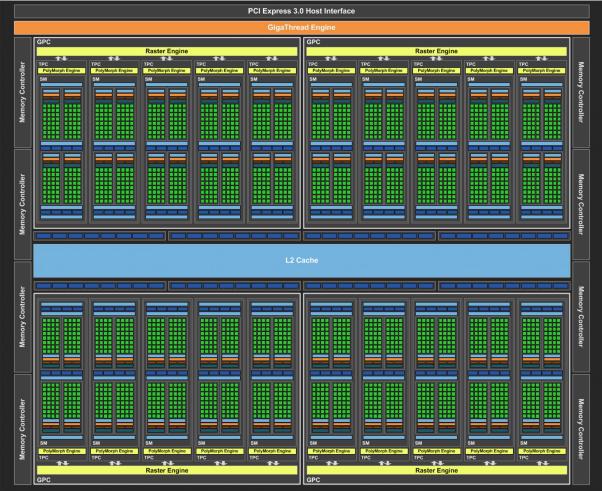
Pascal is designed to offer the highest performance for deep learning and other compute performance.
Pascal is NVIDIA’s successor to their 28 NM Maxwell Architecture. The Pascal microarchitecture uses the 16-nanometer FinFET manufacturing process from TSMC, the Taiwan Semiconductor Manufacturing Company.
With 150 billion transistors, Pascal is the world’s largest FinFET chip ever built. Delivering over 5 Teraflops of double-precision performance, Pascal is also the most powerful architecture ever inside of a GPU.
Features & Specifications
| Product Specifications | |
|---|---|
| Graphics Processing | GeForce® GTX 1080 |
| Core Clock | Boost: 1936 MHz / Base: 1784 MHz in OC mode Boost: 1898 MHz / Base: 1759 MHz in Gaming mode |
| Process Technology | 16 nm |
| Memory Clock | OC mode: 10400 MHz Gaming mode: 10206 MHz |
| Memory Size | 8 GB |
| Memory Type | GDDR5X |
| Memory Bus | 256 bit |
| Card Bus | PCI-E 3.0 x 16 |
| Digital Max Resolution | 7680x4320px @ 60Hz |
| Multi-view | 4 |
| Card Size | H=57 L=287 W=140 mm |
| PCB Form | ATX |
| DirectX | 12 |
| OpenGL | 4.5 |
| Recommended PSU | 500W (WITH TWO 8-Pin EXTERNAL POWER CONNECTOR) |
| I/O | Standard mode (Dual-link DVI-D*1, DP1.4*3, HDMI 2.0b*1) VR mode (Dual-link DVI-D*1, DP*1, HDMI*3) |
| SLI Support | 2-way SLI HB |
Features
- Powered by GeForce® GTX 1080
- Pascal GP104 GPU
- WINDFORCE Stack 3x 100mm fan cooling system
- Xtreme VR Link provides the best VR experience
- 16.8M customizable color lighting
- Xtreme SLI bridge with light effect
- Stylish Metal Back Plate
- Titan X-grade Chokes and Capacitors for Extreme Durability
- Intuitive Xtreme Engine
- Xtreme Care provides a 4-year warranty (Online registration required)
Accessories
- Xtreme VR Link extended 5.25” front panel (2 HDMI ports and 2 USB3.0 ports)
- Xtreme VR Link extended bracket
- Xtreme SLI bridge
- XMP300 mouse pad
- Xtreme Gaming member club registration guide
- Graphics card quick manual
- Paper folder
- Wrist protector
- PCI-E Power cable x1 (Two 6pin to 8 pin)
- Xtreme Gaming Sticker
- Xtreme Gaming Case badge
Packaging & Unboxing
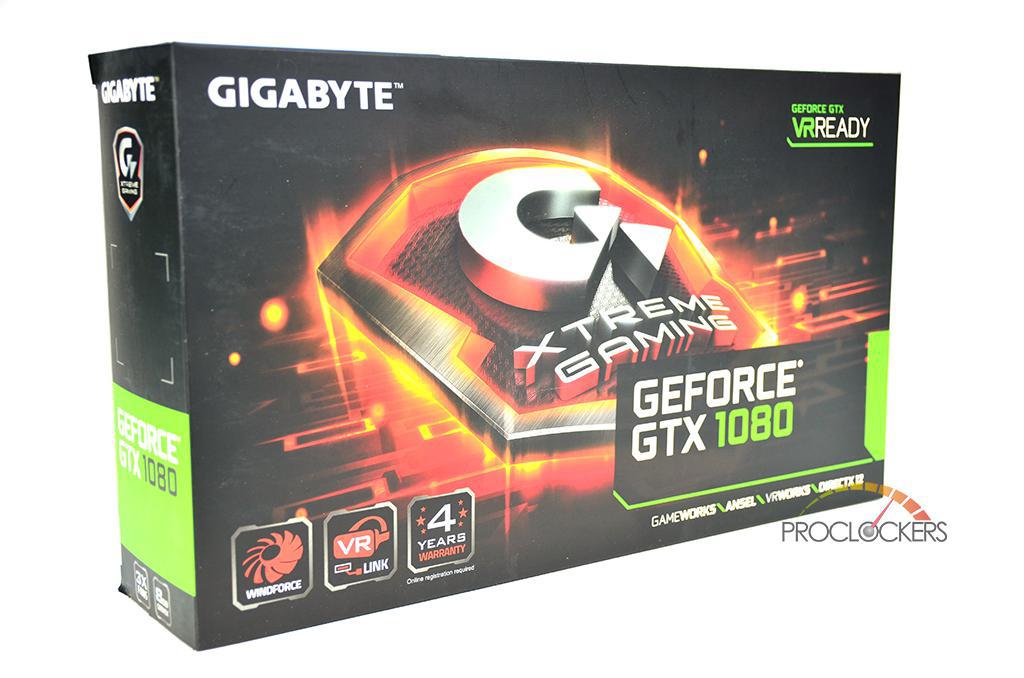
Here is the Standard packaging for the GIGABYTE Extreme Gaming 1080.
The Extreme Gaming GTX 1080 comes in two different packages.
The first is the standard package, which comes packed with the Extreme Gaming GTX 1080 and the normal literature, and packed in the standard size box.
The box has the GIGABYTE Extreme Gaming logo and the NVIDIA GTX 1080 product branding on the front.
However, the sample GIGABYTE send us had the premium accessory package included. This came with several excellent additions to the Extreme Gaming GTX 1080.
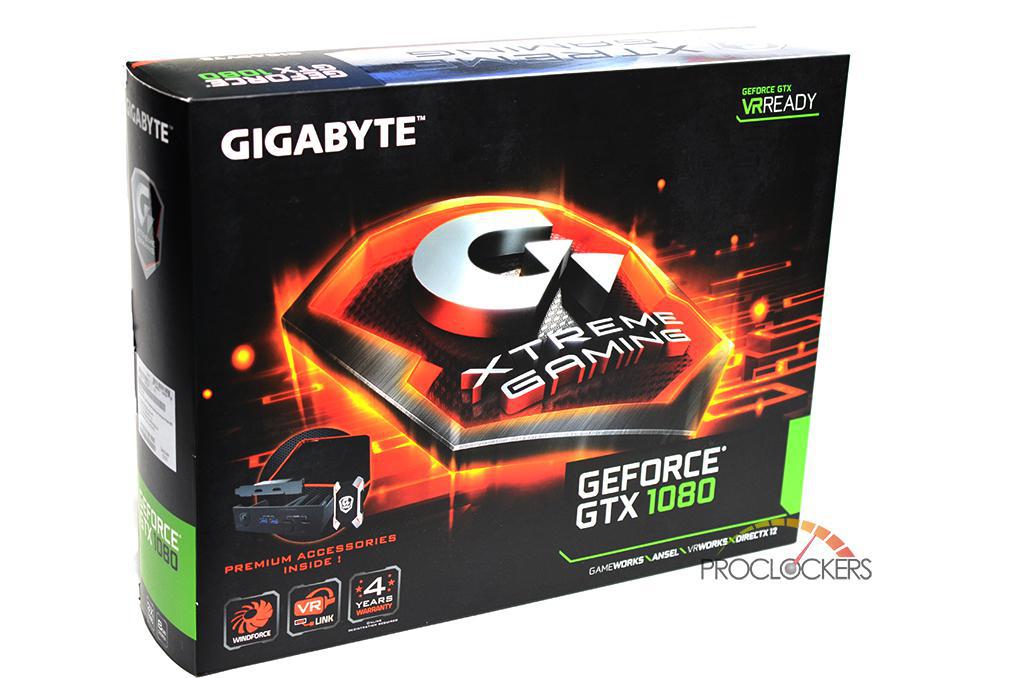
Due to the premium accessories packed with the Extreme Gaming 1080, this package is much larger.
The box is also significantly larger than the standard edition and comes with an array of accessories.
The box stands 13.5 inches tall, just over 17 inches long, and weighs 7.2 pounds.
These accessories include a High Bandwidth SLI bridge, metal case badge, wrist band with the extreme gaming logo on it, and XMP300 mouse pad, Xtreme VR Link extended 5.25” front panel (2 HDMI ports and 2 USB3.0 ports), Xtreme VR Link extended bracket for expansion slot, Xtreme Gaming member club registration guide, Graphics card quick manual, Paper folder, PCI-E Power cable x1 (Two 6pin to 8 pin) and an Xtreme Gaming Sticker.
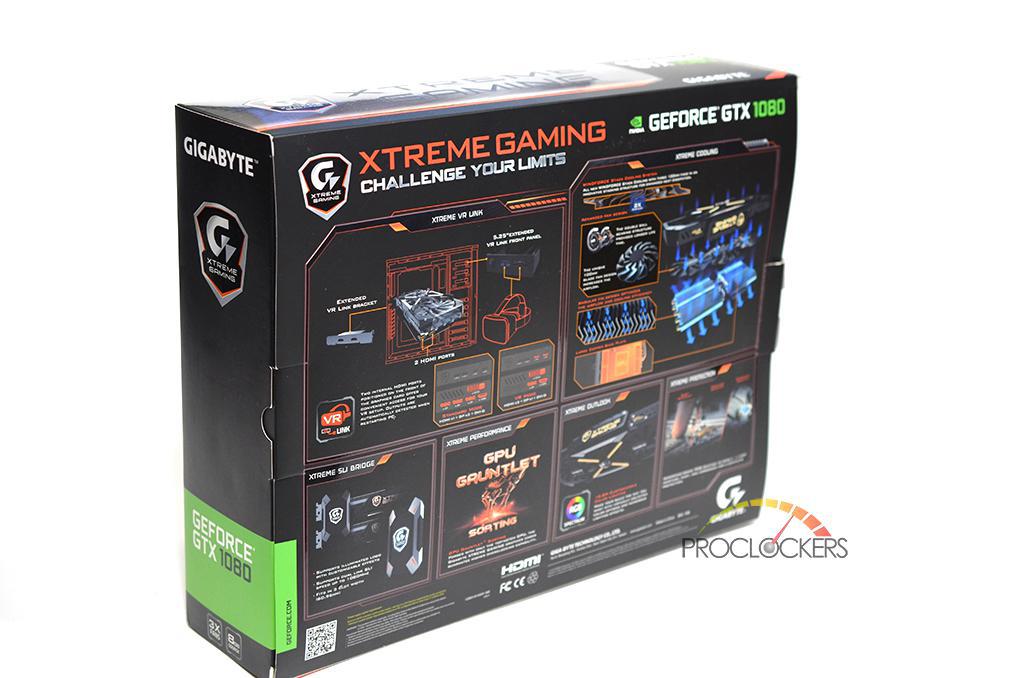
The rear of the package has a lot of information such as how the cooling and VR link work, as well as information on GIGABYTEs GPU Gauntlet and even the manufacturing process.
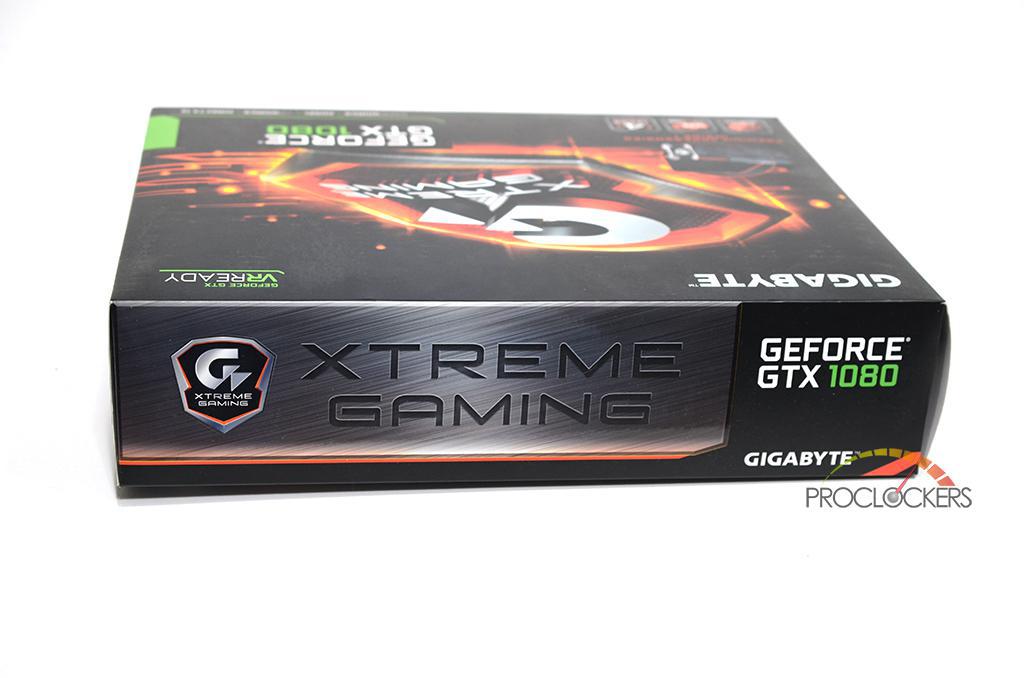
The top of the package has the XTREME GAMING logo and branding in large print next to the GEFORCE GTX 1080 branding and GIGABYTE logo.
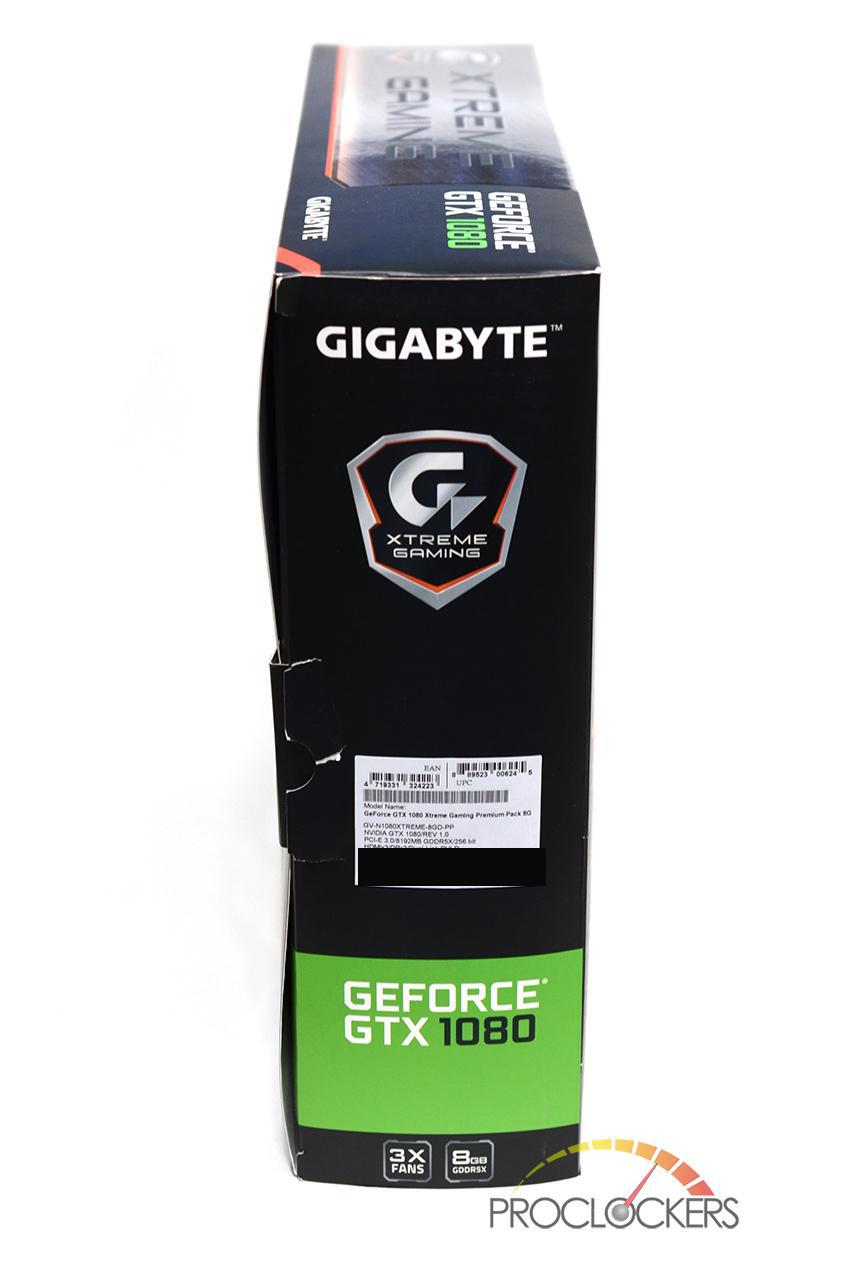
The left side of the package is where you can find such information as the serial number, model number, and UPC code.
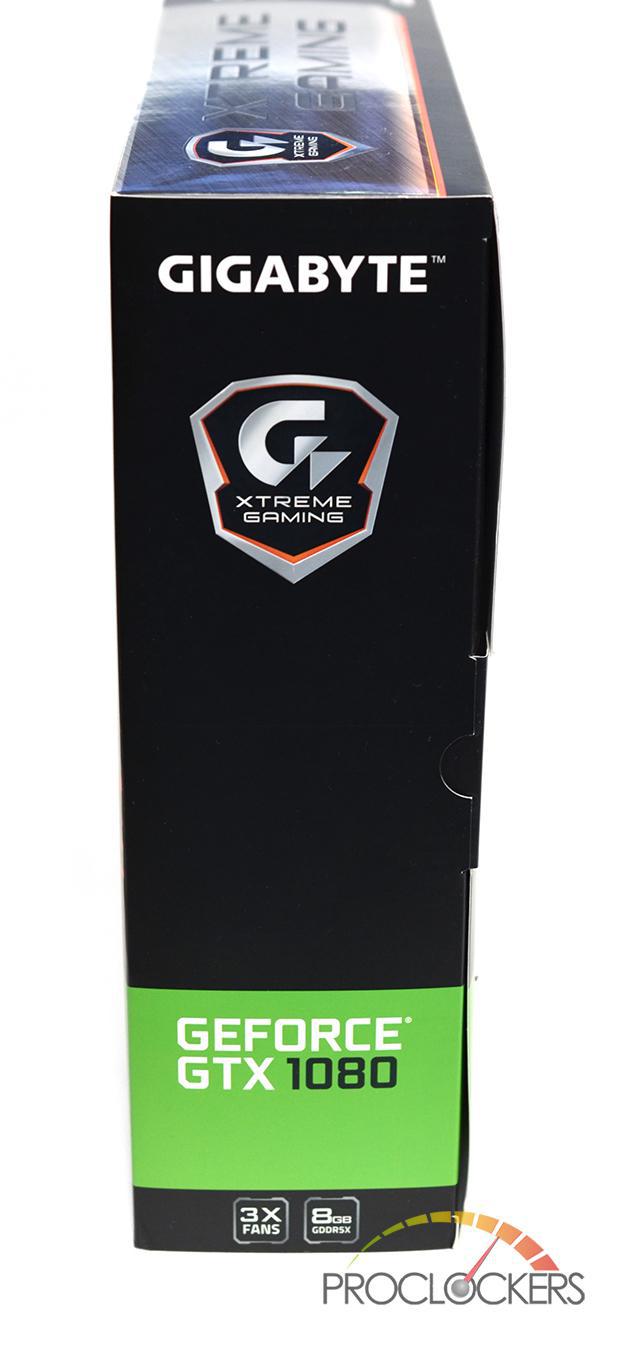
The right side of the package has the GIGABYTE and XTREME GAMING logo’s and the GEFORCE GTX 1080 product branding.
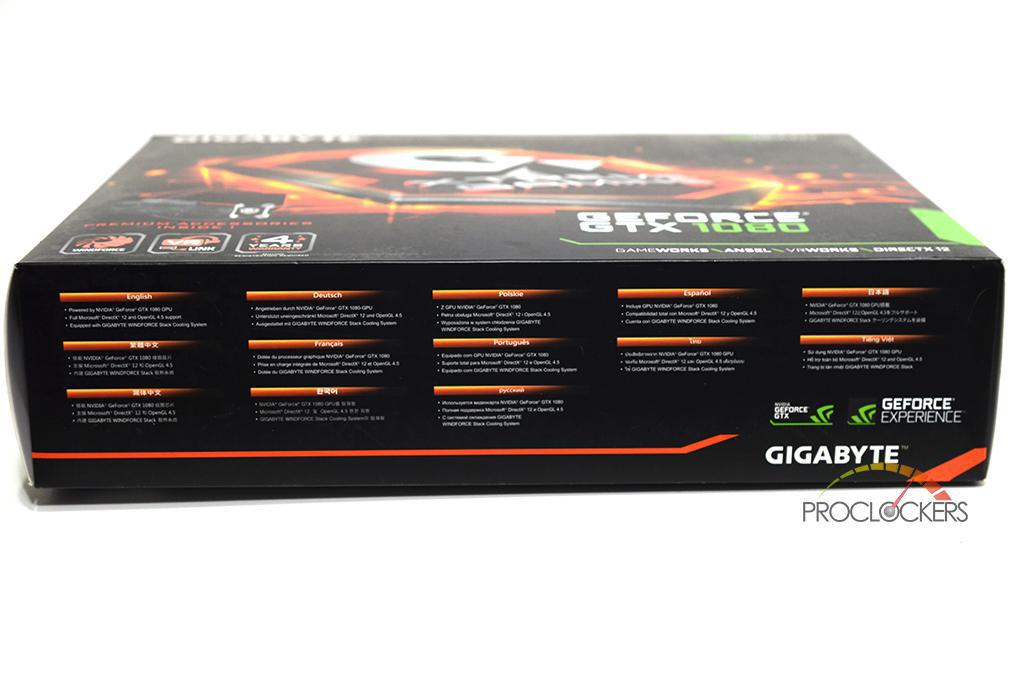
The bottom of the package lists a few key features such as DX12 support and the Windforce cooler, in several languages.
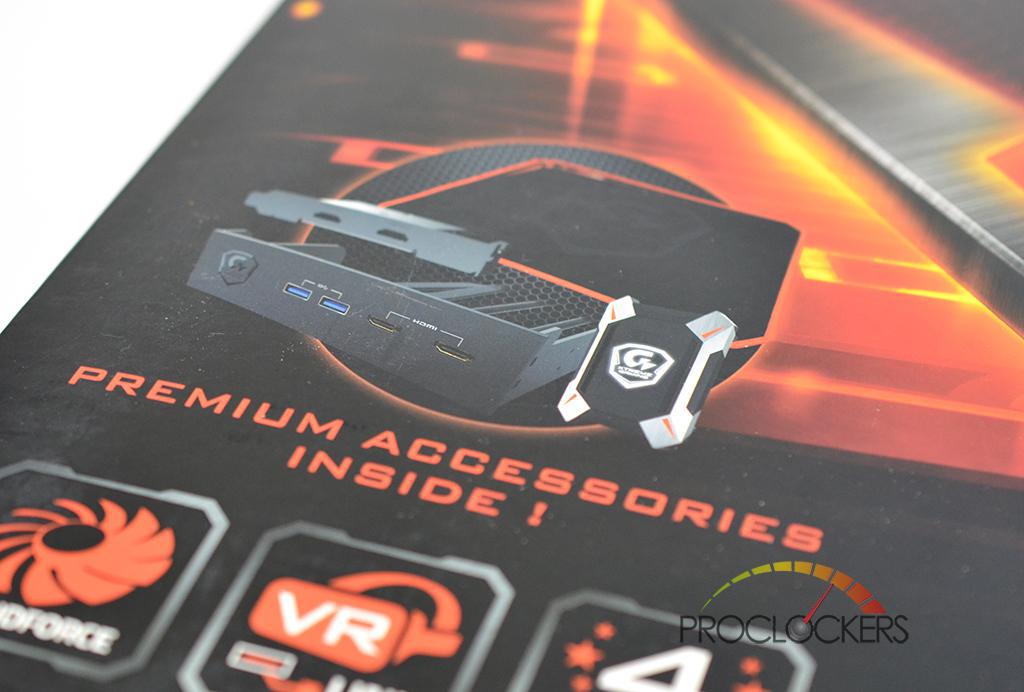
The front of the box has a depiction of the VR Link, with the bracket and the HB SLI Bridge.
The front of the package has the GIGABYTE logo in the top left corner, and “GEFORCE GTX VR READY” to the right, In the center of the box, there is a very large, XTREME GAMING logo.
Near the bottom right corner, you see the GEFORCE GTX 1080 product branding.
To the left, you see a depiction of the VR Link, with the expansion slot bracket, as well as the HB SLI bridge.
Below that, are a list of a few features. These are the Windforce cooler, VR Link, and the extended 4-year warranty.
The rear of the package is packed with information. On the top left, there is the XTREME GAMING logo and product branding.
Below that is the phrase “Challenge Your Limits”. To the right, you find the NVIDIA logo and GEFORCE GTX 1080 branding. The first diagram on the back depicts the VR link and how it works.
The next depiction is of the Windforce cooler, and how it’s designed to work.
There are also pictures and descriptions of the HB SLI bridge and the RGB lighting on the card. There is also a brief explanation of the GPU Gauntlet and the manufacturing process.
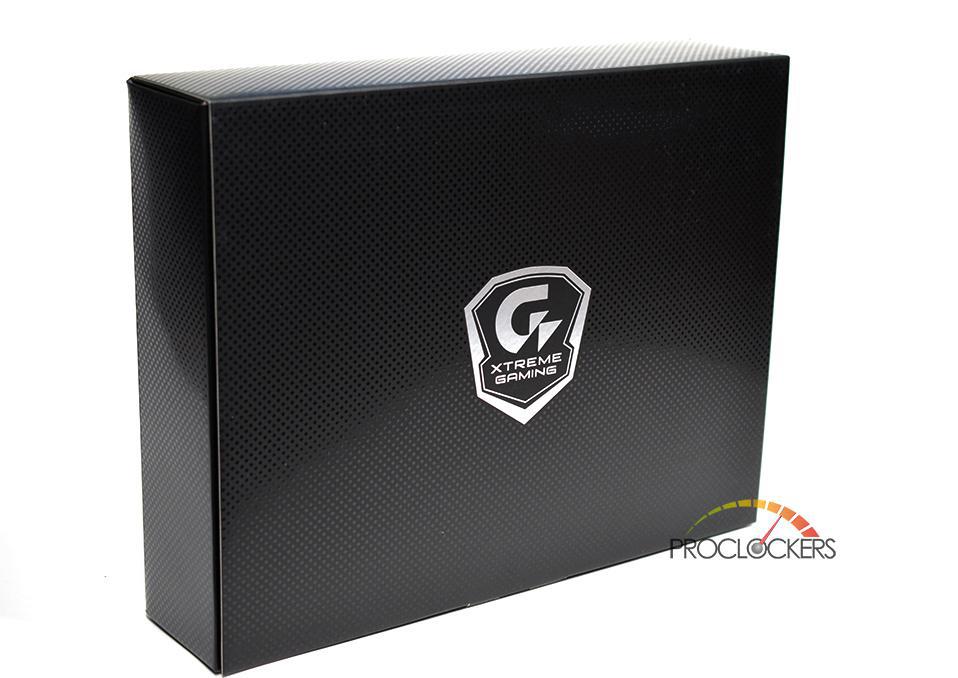
Inside, there is another box with the XTREME GAMING logo in the center of it.
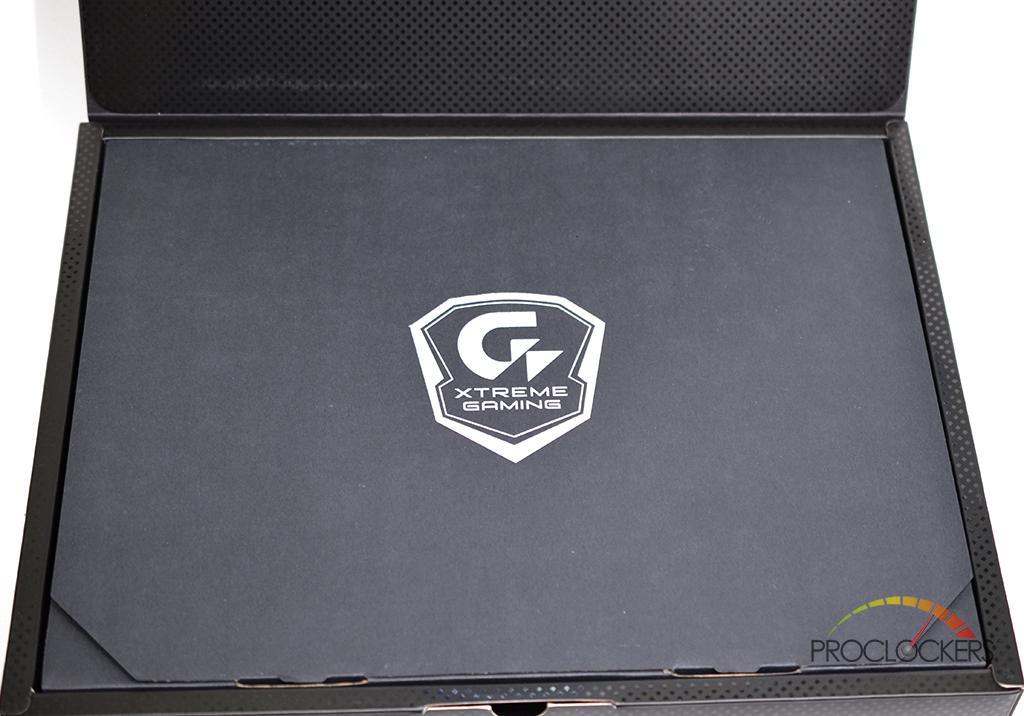
When the box is opened, we find another smaller box with the XTREME GAMING logo on it as well.
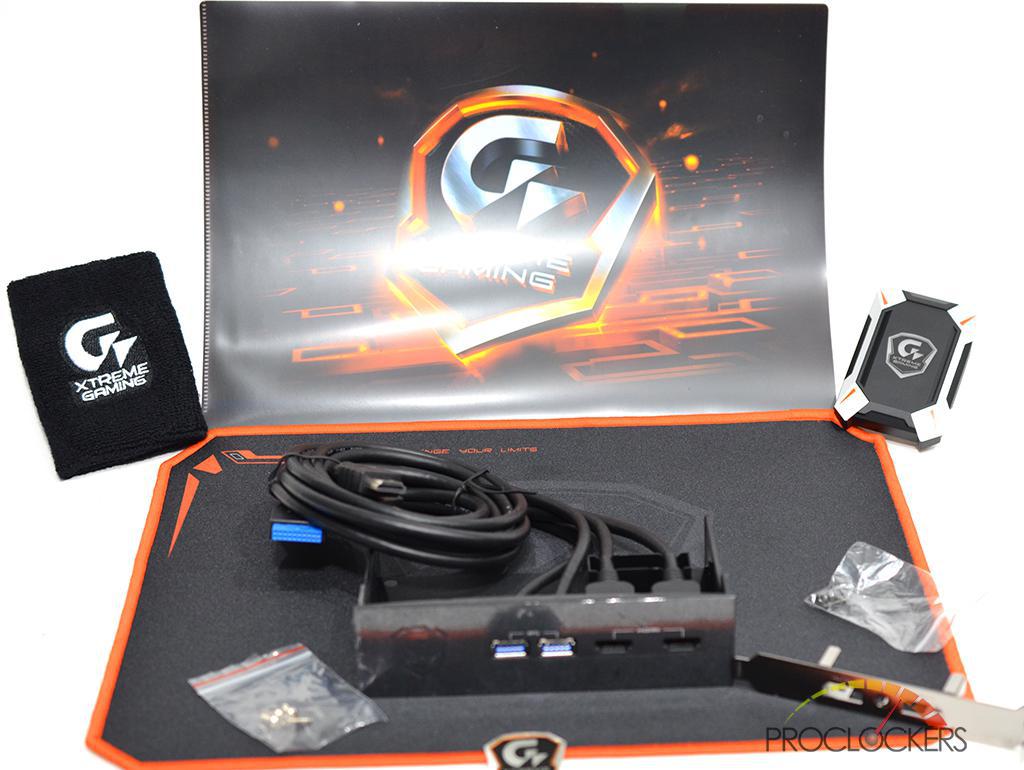
Here are all of the accessories that come packed with the XTREME GAMING 1080 with the premium accessories.
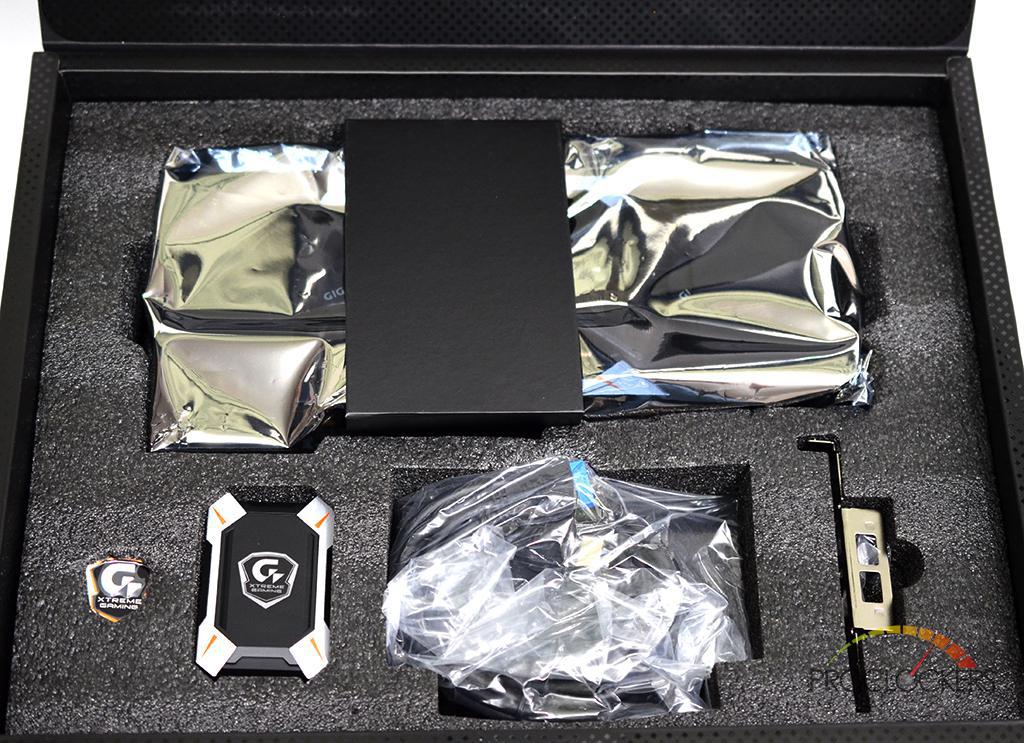
The XTREME GAMING 1080 come beautifully packed with the HB SLI Bridge, VR Link and bracket and the metal case badge.
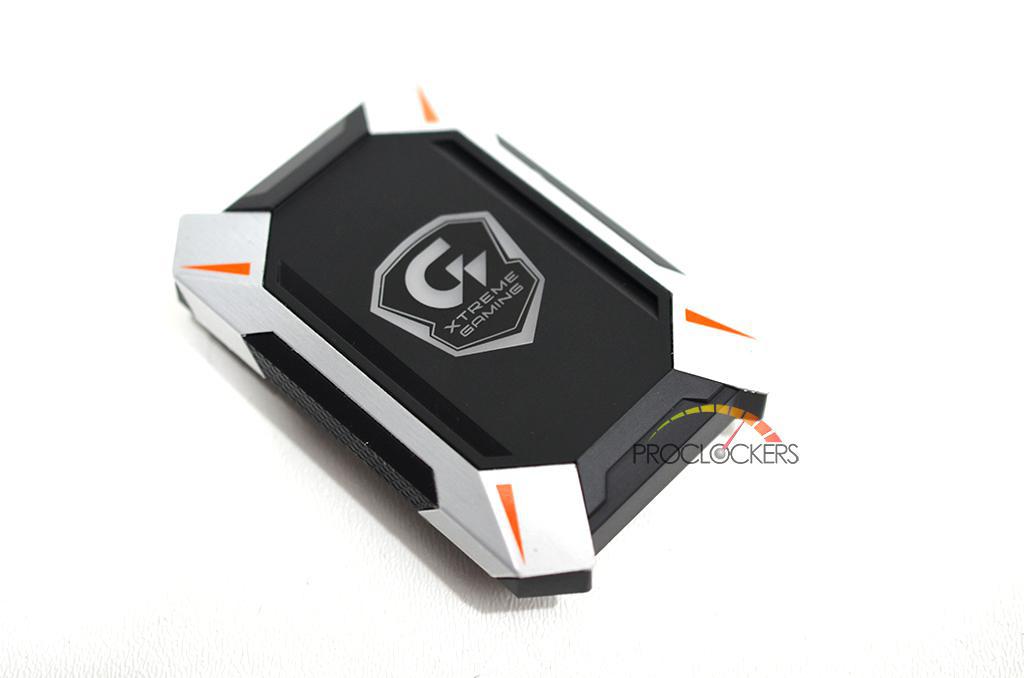
Here is the front of the XTREME GAMING branded HB SLI Bridge with LED lighting.
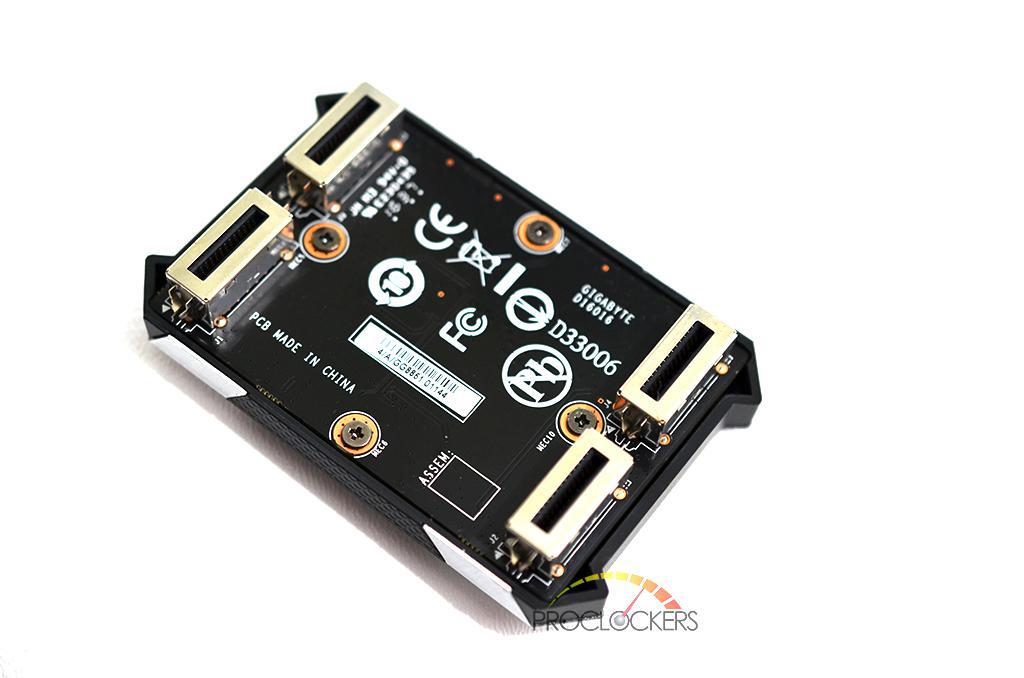
The rear of the HB SLI Bridge.
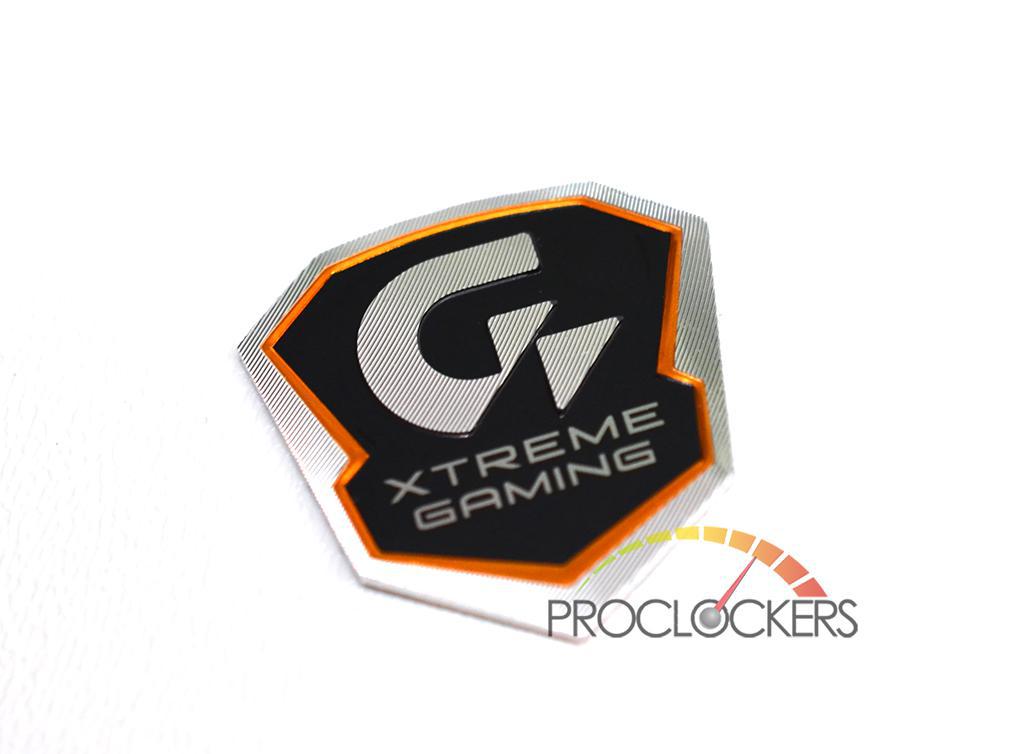
The Metal XTREME GAMING Case Badge is beautiful, and my second favorite item in the box, next to the card itself.
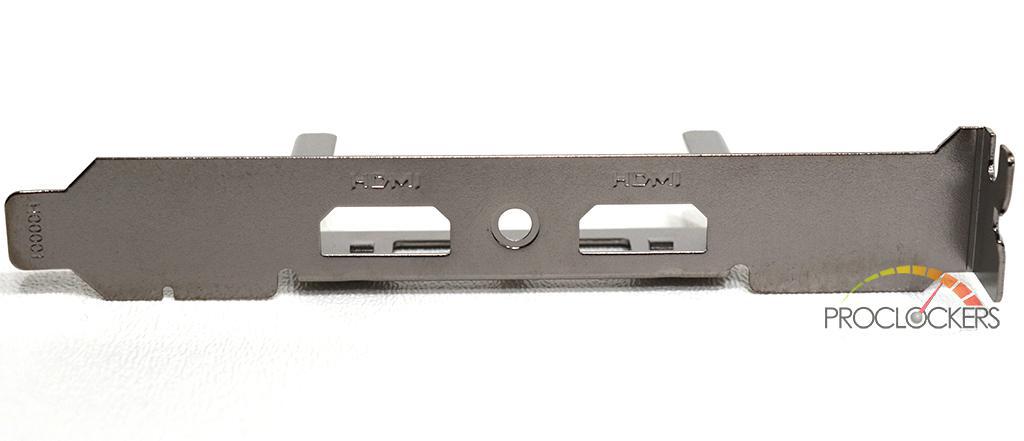
This bracket is used with the VR Link if you would rather have the HDMI passthrough in an expansion slot, rather than plugged into the card itself.
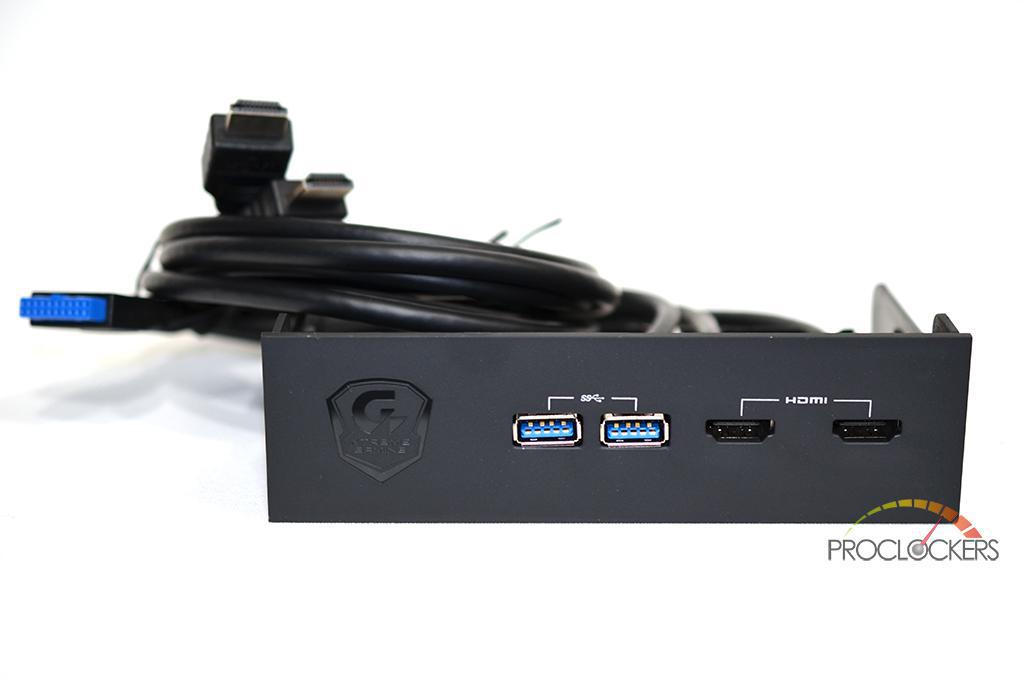
The VR Link fits into a 5.25” bay and gives you 2 additional USB 3.0 and 2 HDMI passthrough.
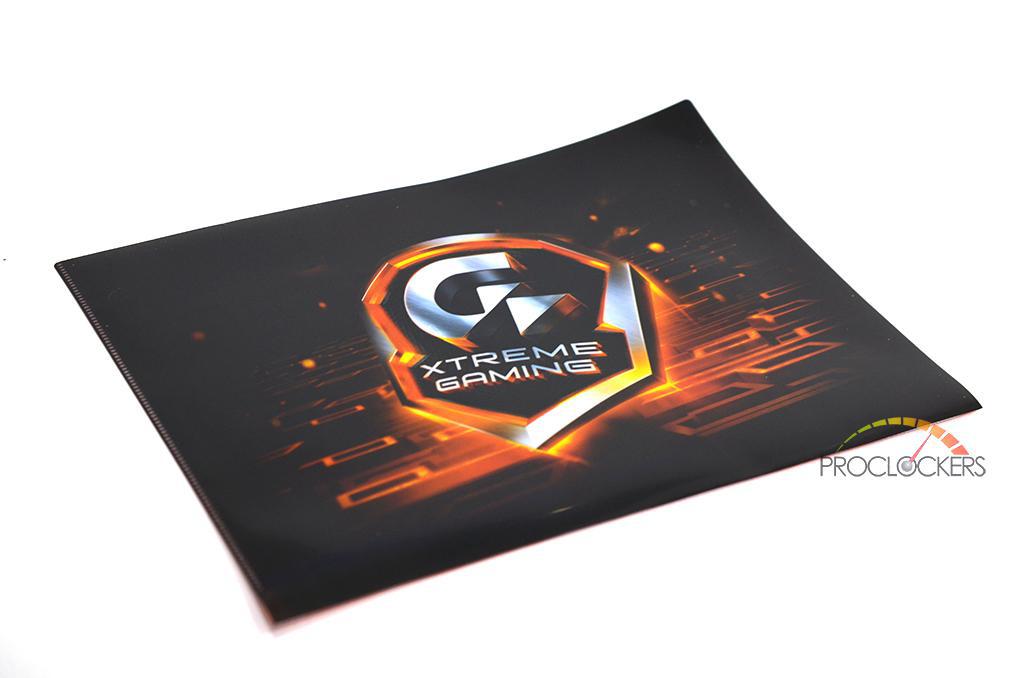
This folder comes with the extended 4-year warranty information.
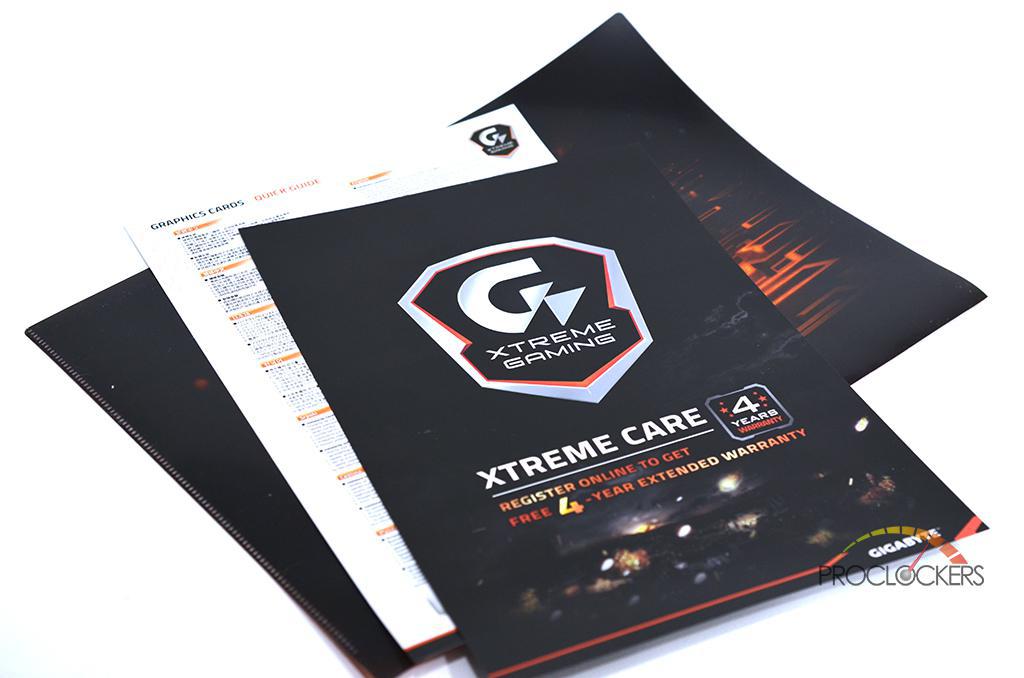
Here are the contents of the folder.
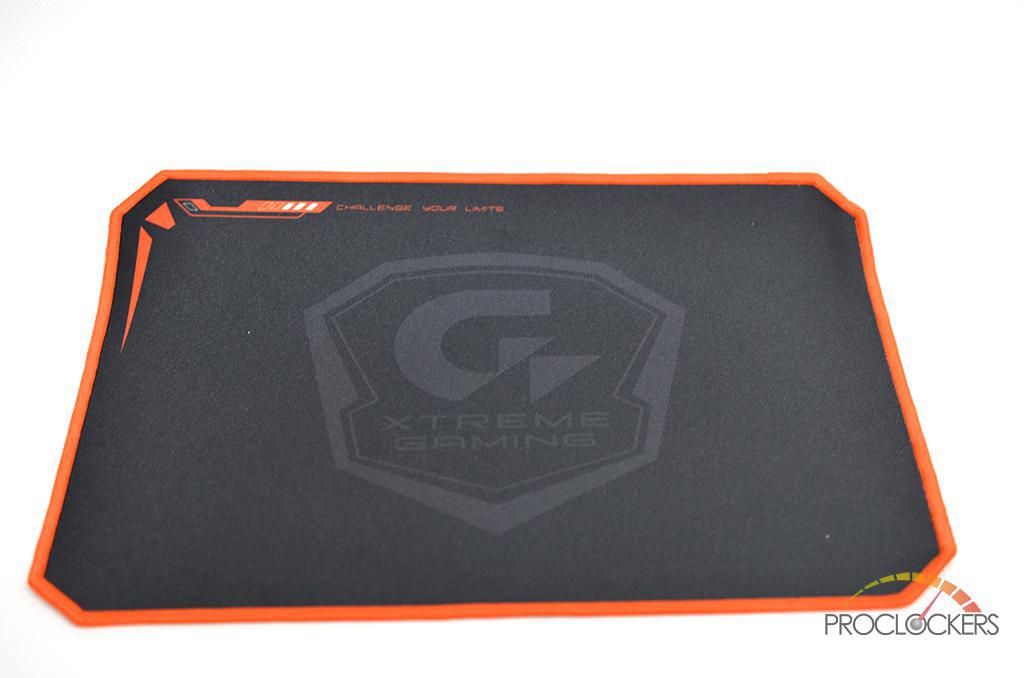
The XTREME GAMING 1080 comes with an XMP300 mouse pad.
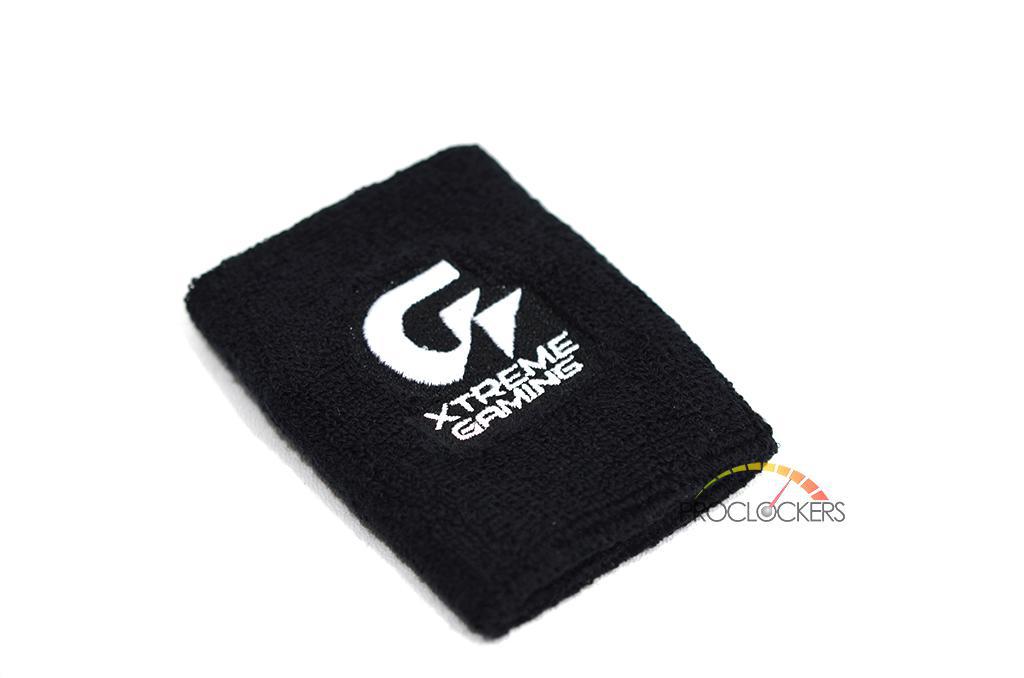
This wrist band also comes packed on with the mouse pad and paperwork box.
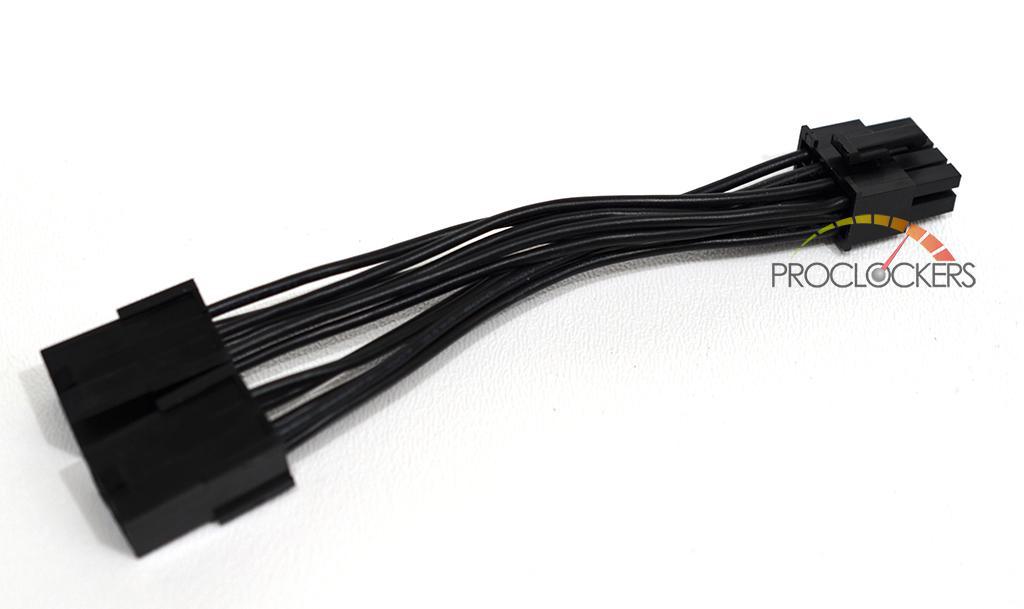
This dual 6 -pin to 8-pin adapter is also packed with the accessories.
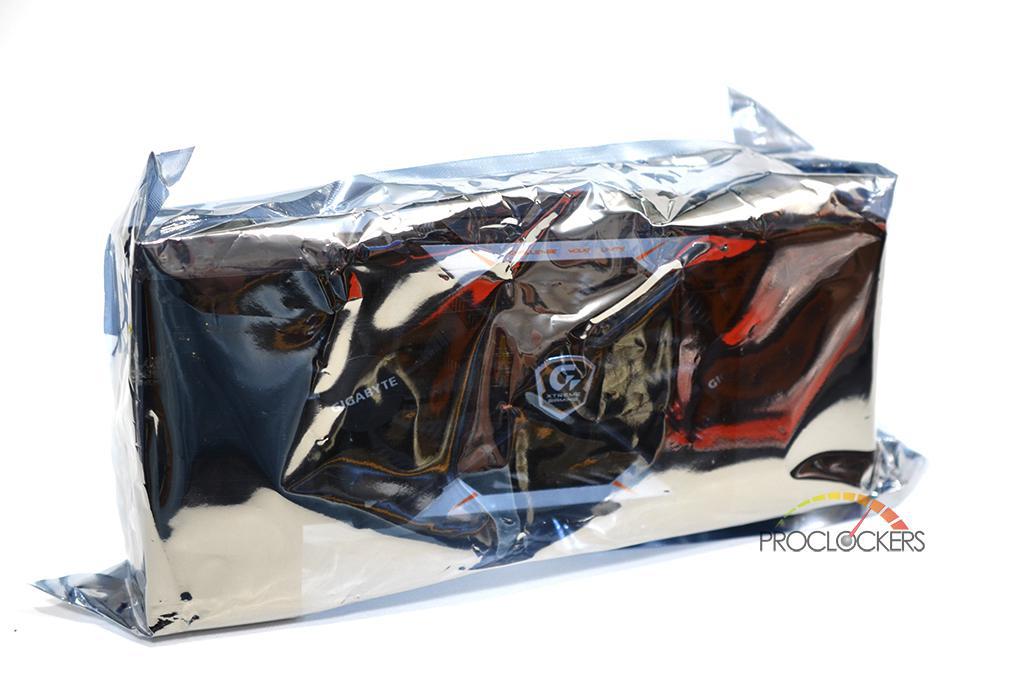
Like all other cards, it comes in an anti-static bag.
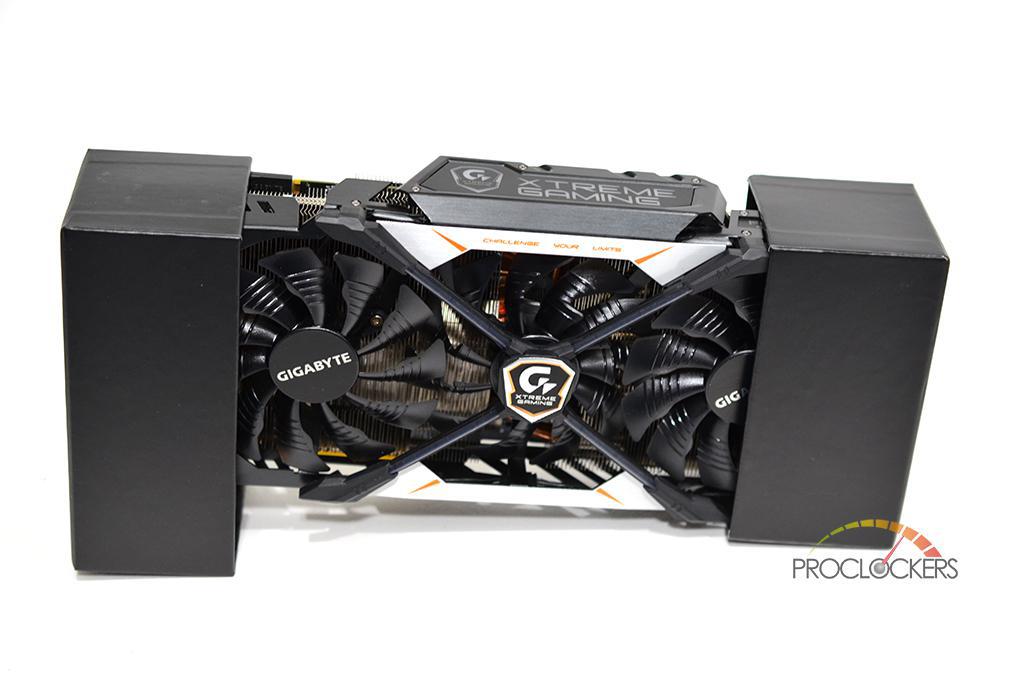
Unlike most cards, the XTREME GAMING 1080 comes with protective cardboard at either end of the card. This is a great touch!
The smallest of the boxes comes with the warranty paperwork packed inside.
Also in the smallest box is a GIGABYTE XMP300 mouse pad, an XTREME GAMING wrist band, and a dual 6 -pin to 8-pin adapter, if your PSU doesn’t have more than one 8-pin connector.
However, I’d recommend only using this solution until you get a new PSU if you plan to run this card.
The larger box is padded with soft foam. I love soft foam. It provides excellent protection during shipping and storage.
Hard foam works too but is essentially useless once it cracks.
The foam has cutouts for the XTREME GAMING 1080, the VR Link, the VR Link bracket, and the metal case badge.
There is even a 3-sided piece of cardboard that slides over the center of the card for extra support. I’d have to say, this is the best-packed card I’ve personally ever had the privilege of unboxing.
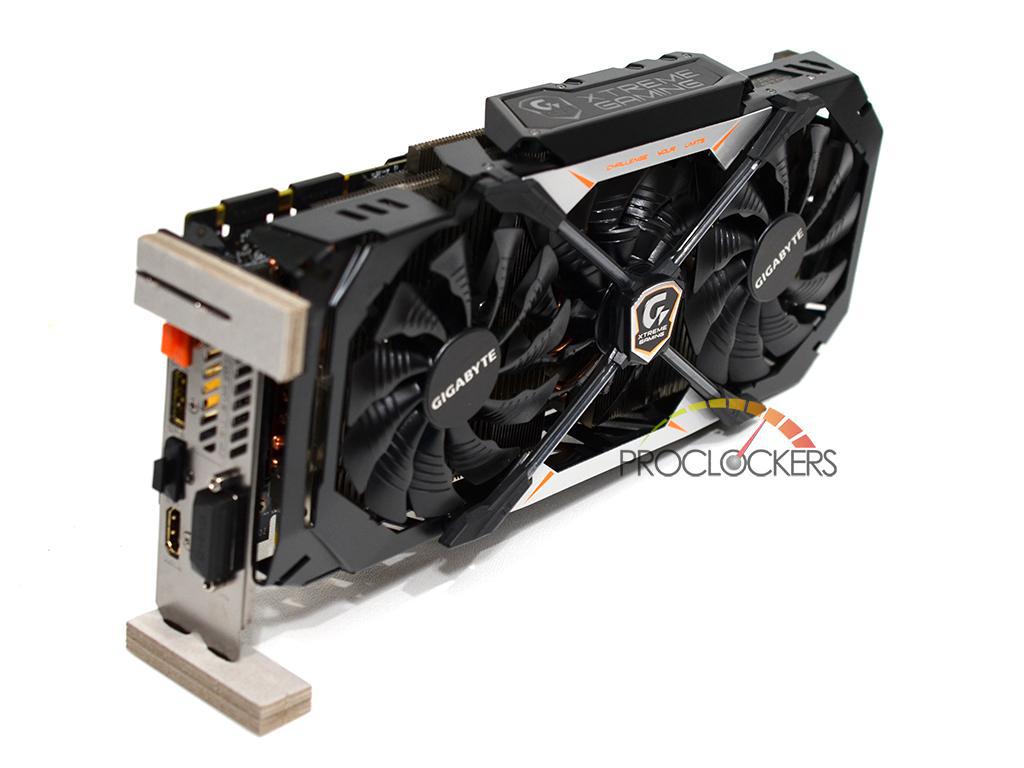
The IO bracket even came with very thick pieces of cardboard to protect the ends of the bracket.
A Closer Look
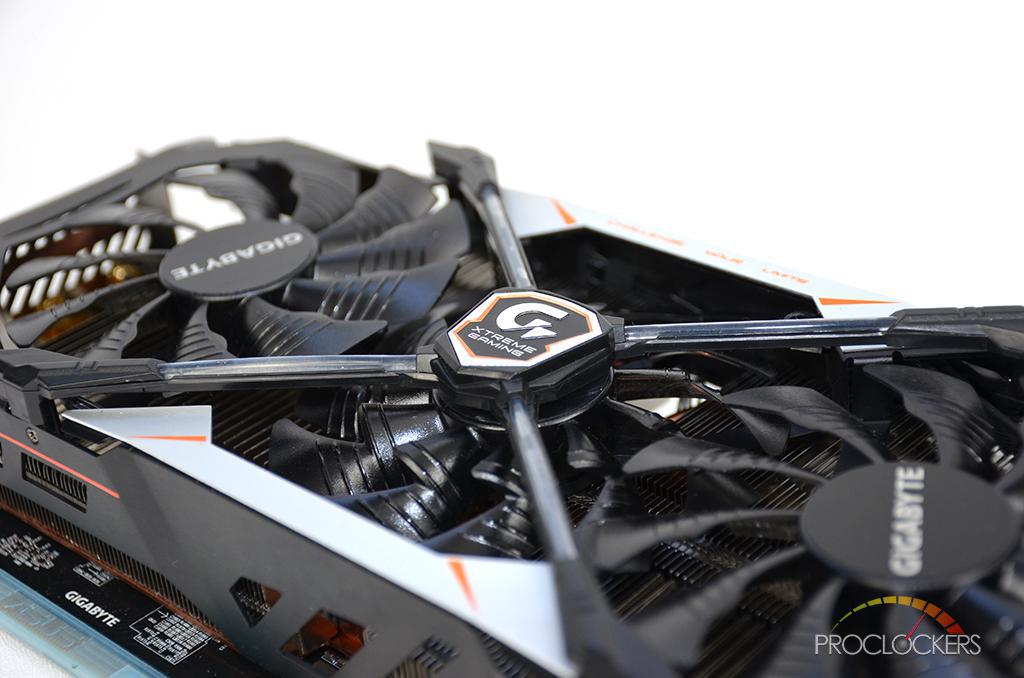
The side fans overlap the center fan a bit.
The XTREME GAMING 1080 is a beautiful card.
It measures 11.5 x 5.5 x 2.2 inches and weighs a touch over 3 pounds. This is a massive card. While the IO takes up 2 slots, the card itself takes up almost 3 slots.
The cooler on The XTREME GAMING 1080 is GIGABYTE’S Windforce Stack 3X cooling system.
This cooler features GIGABYTE patent-pending, 3X 100mm stack fans. The fans on either end of the card are slightly higher than the center fan and overlap the center fan a bit on either side.
The shroud of the Windforce cooler is black and silver with orange accents. There is an RGB lit X going through the center of the cooler shroud.
In the center of the cooler, there is the XTREME GAMING logo. The 2 end fans have the GIGABYTE logo on either of them.
The XTREME GAMING logo is also near the center of the backplate that comes installed on the card.
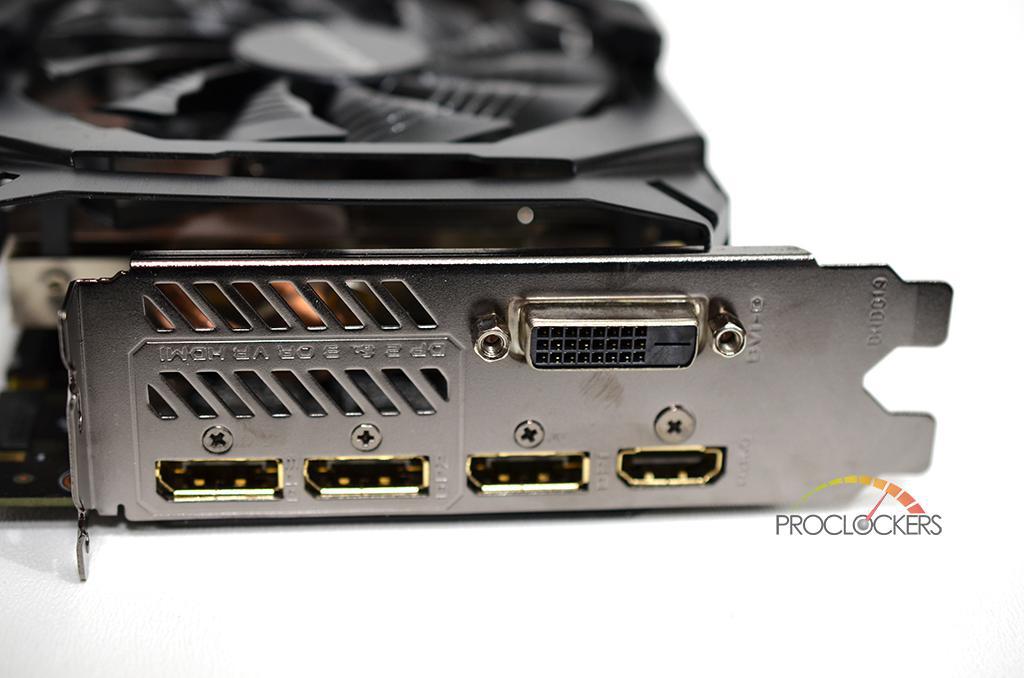
This card requires 2 x 8-pin power connectors and requires a minimum of a 500-watt power supply.
It does come with a dual 6-pin to single 8-pin connector.
However, I do not recommend using this adapter long-term.
The IO of the card has a single DVI-D, 3 DisplayPort 1.2 and a single HDMI 2.0b. There are also 2 more HDMI 2.0b on the rear of the card for use in VR mode with the VR Link.
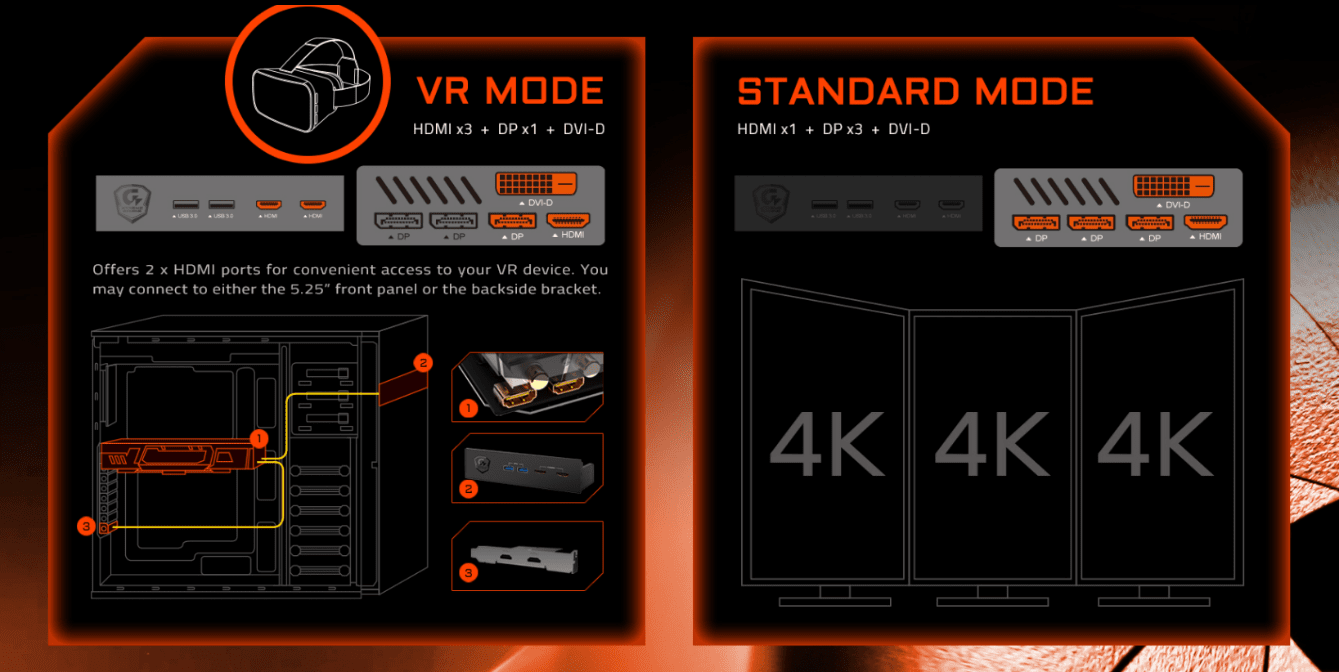
In Standard mode, you have the full IO of the card in use. In VR mode, you lose 2 DisplayPort and gain 2 HDMI.
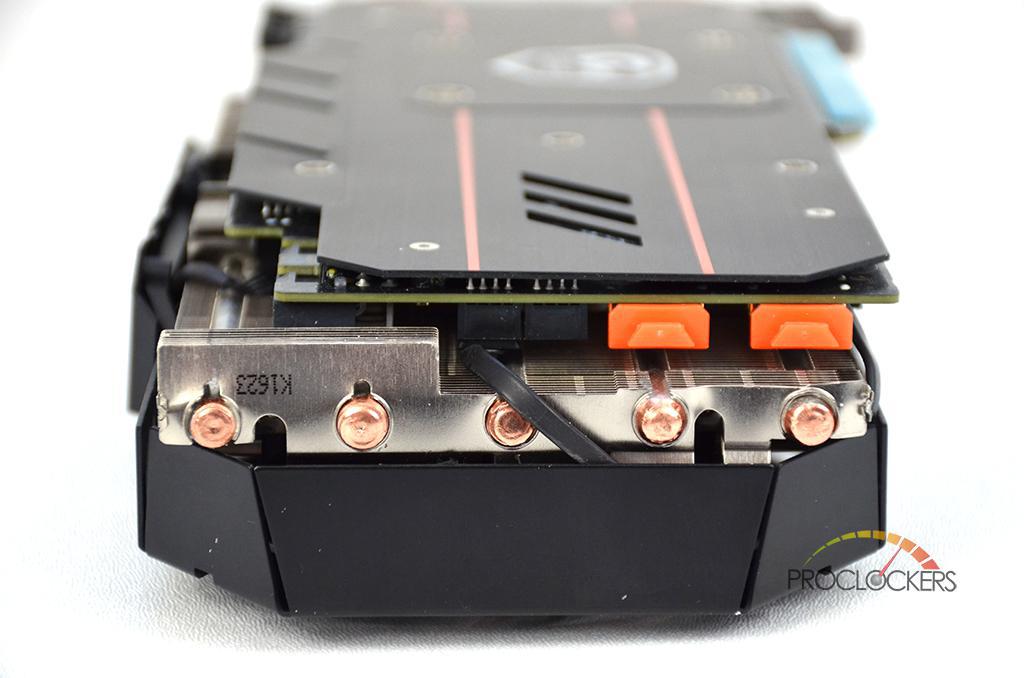
The HDMI passthroughs can connect to the rear of the card, or to a bracket that gets installed in an expansion slot.
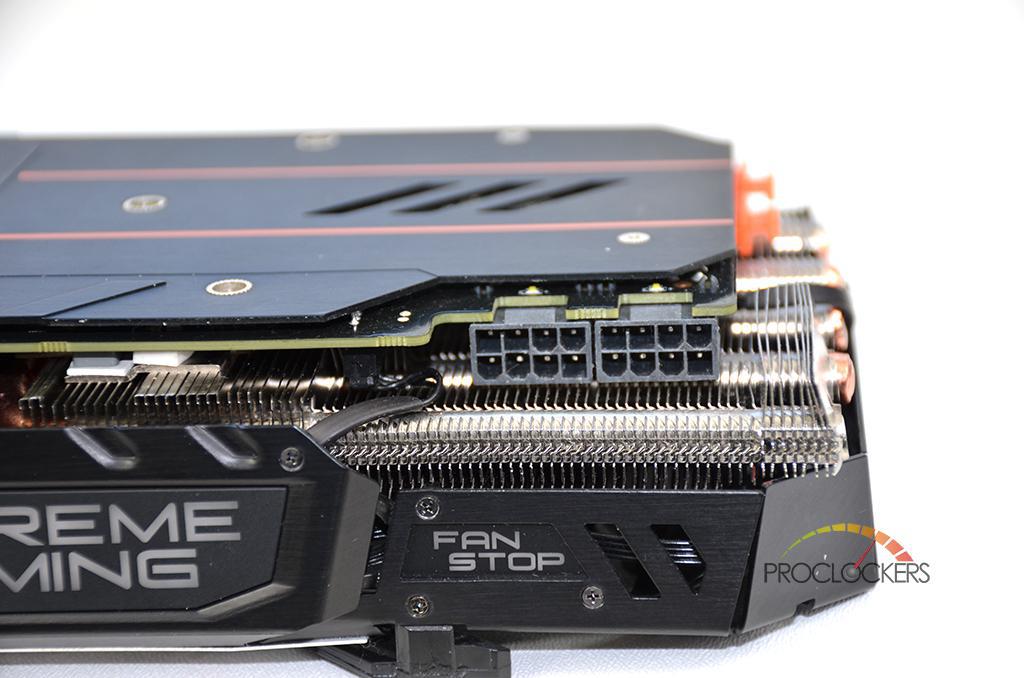
Here you see the 2 x 8-pin power connectors and the FAN STOP led. This LED lights up when the GPU temp drops below a set temperature.
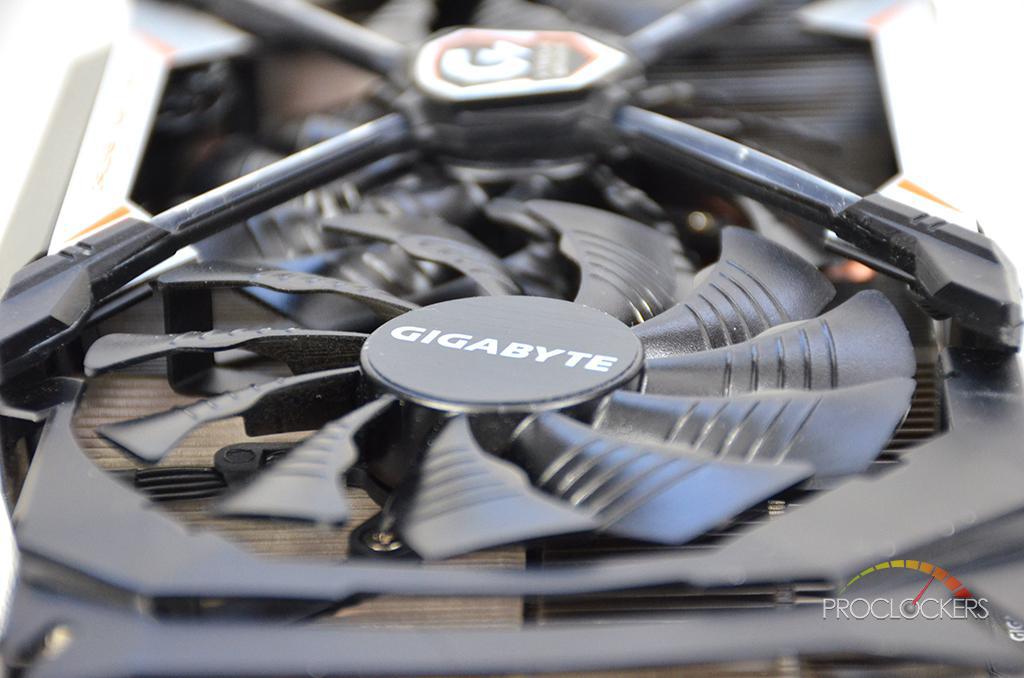
The fans have a triangular design on the blades edge.
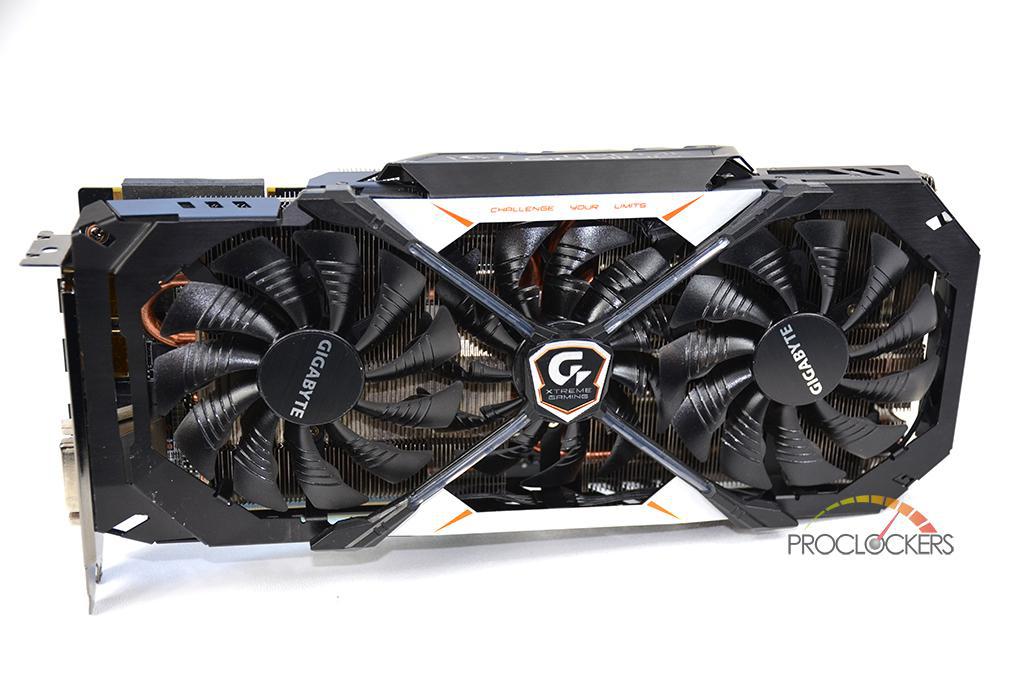
The XTREME GAMING 1080 measures 11.5 inches in length.
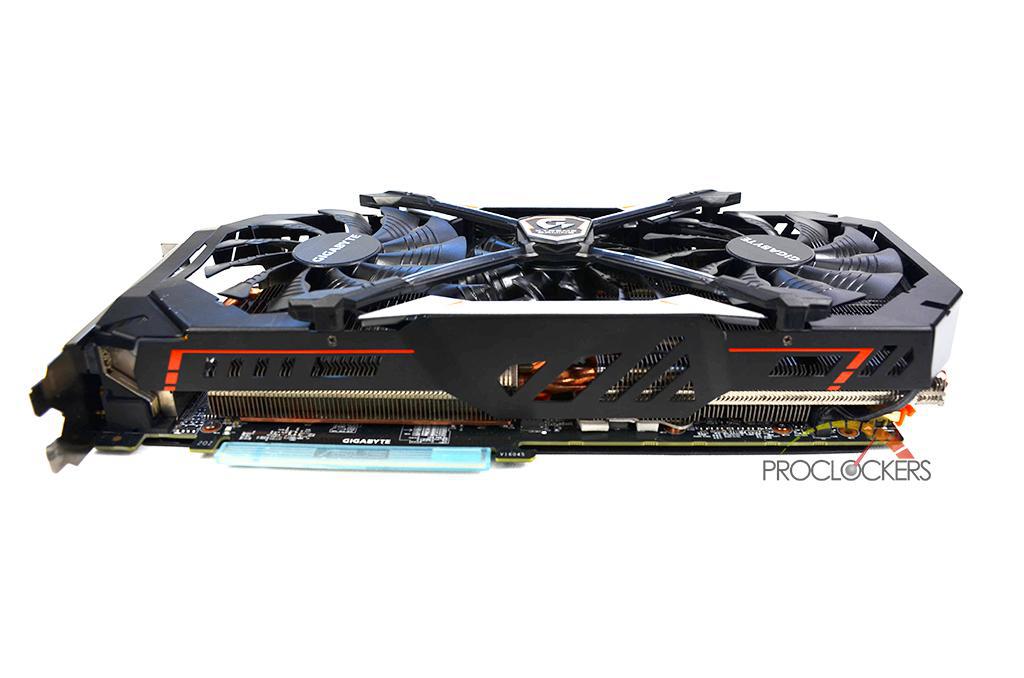
The XTREME Gaming 1080 is 2.2” tall and weighs 3 pounds.
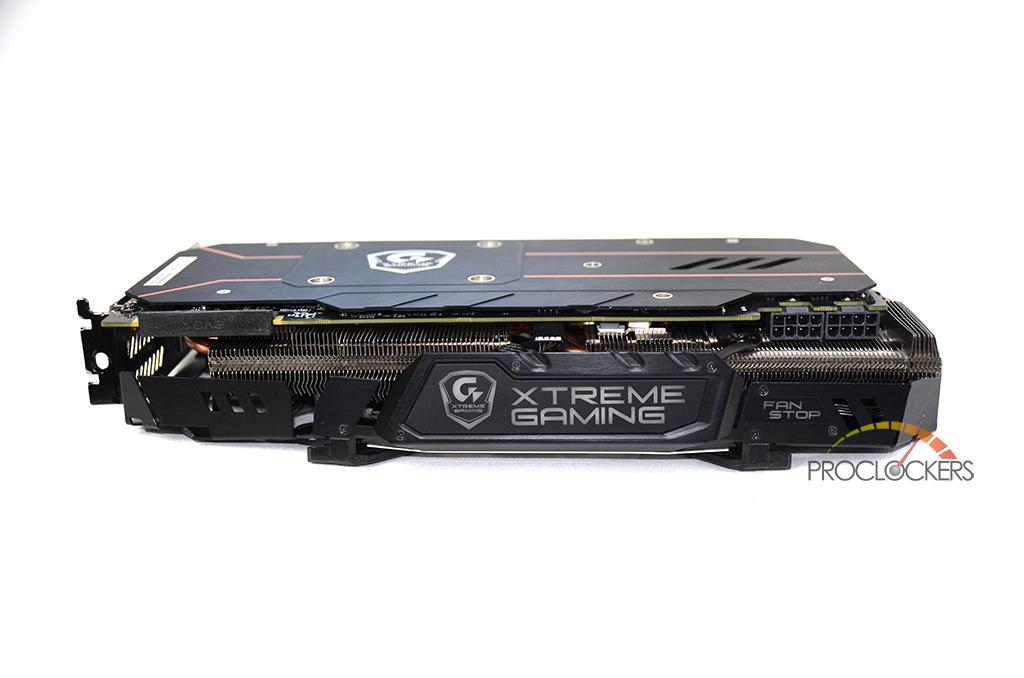
The XTREME GAMING logo and FAN STOP LEDS on the side of the card are RGB backlit and can be controlled by the RGB Fusion software.
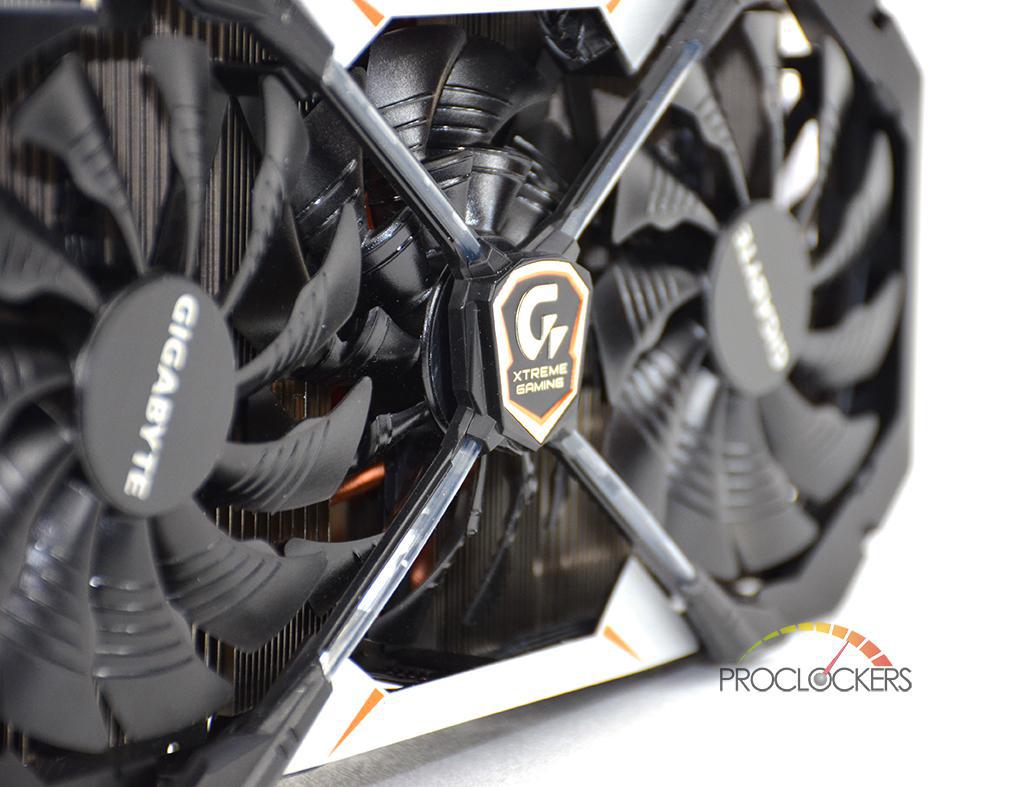
The “X” design over the center fan is also RGB backlit.
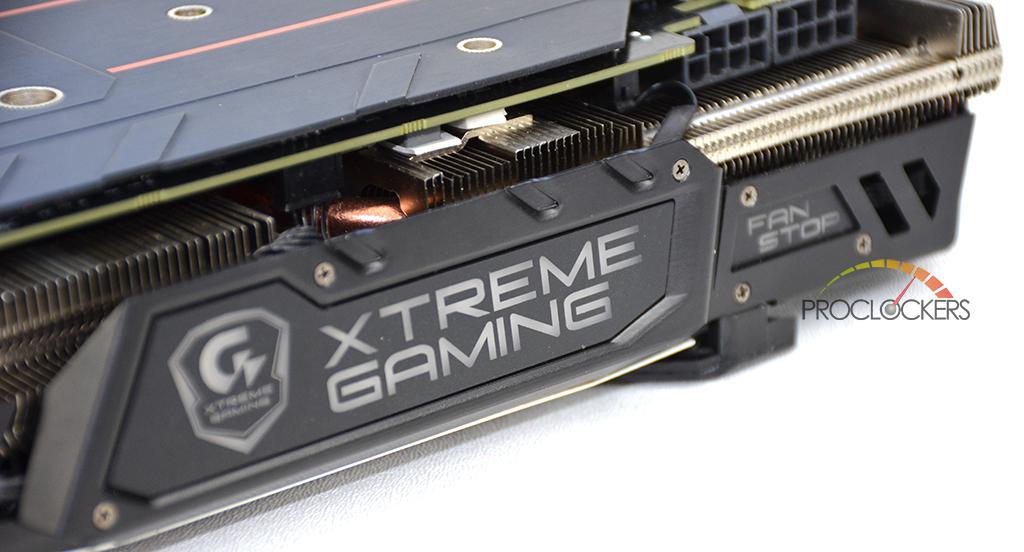
A closer look at the XTREME GAMING RGB logo.

This card requires 2 x 8-pin connectors. When PCI-E voltage is unstable with the smart power LED indicators. When experiencing any power abnormality, the indicator LEDs above the connector, will alert you by flashing.
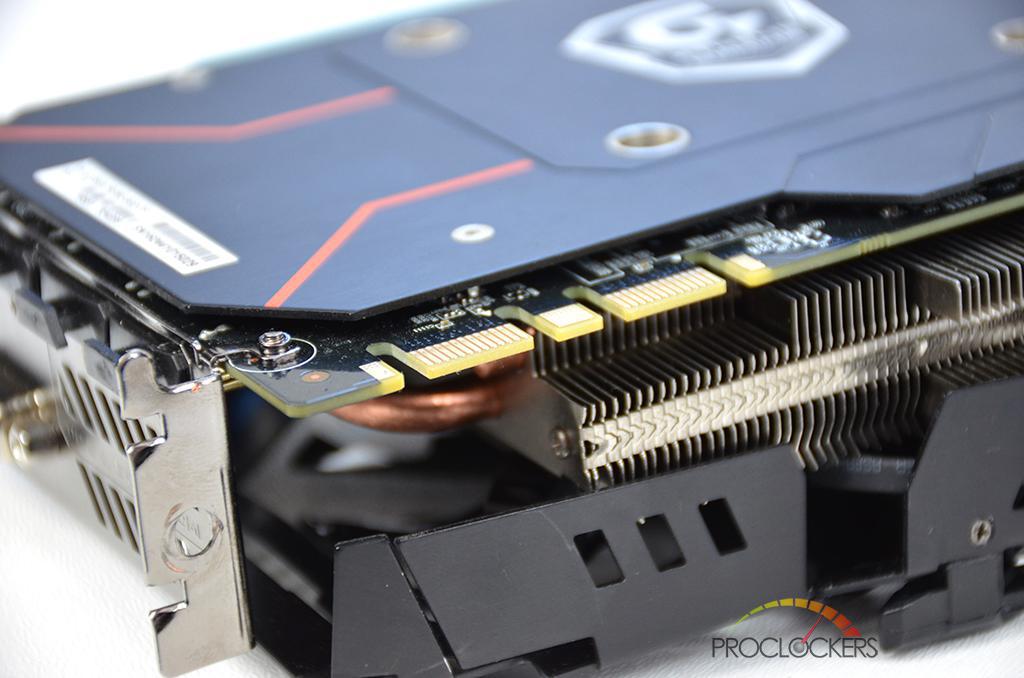
The XTREME GAMING 1080 has support for 2-way SLI.
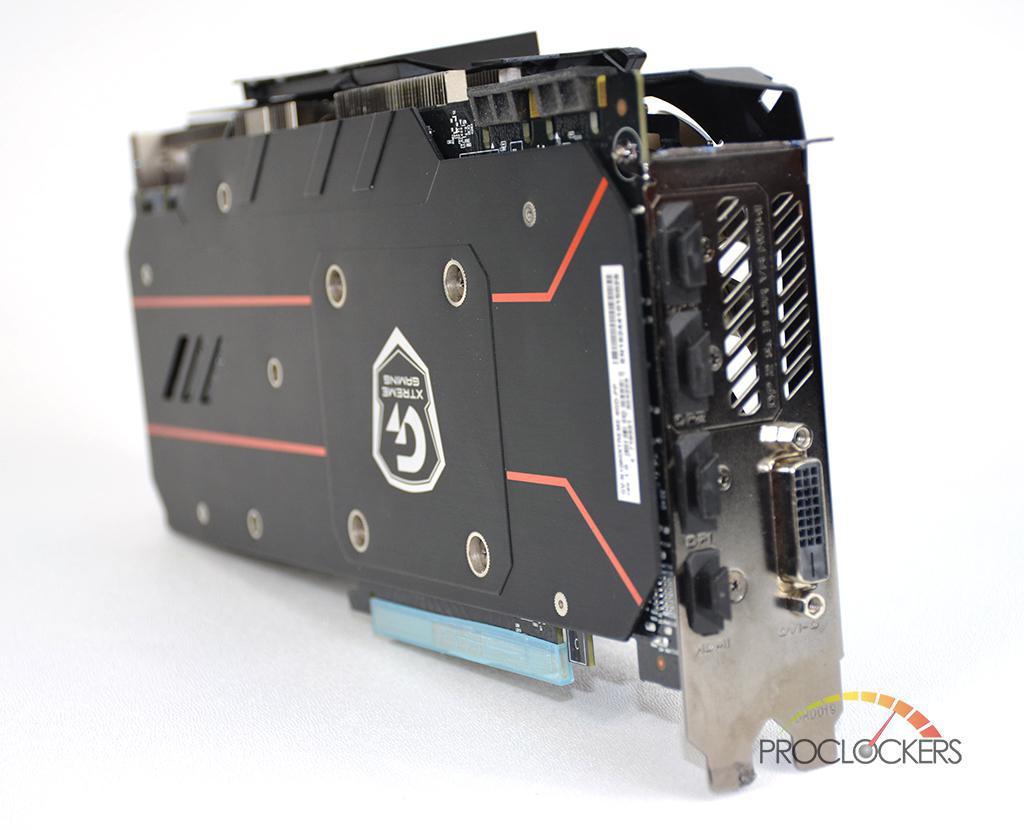
The XTREME GAMING 1080 comes with a black back plate with orange stripes.
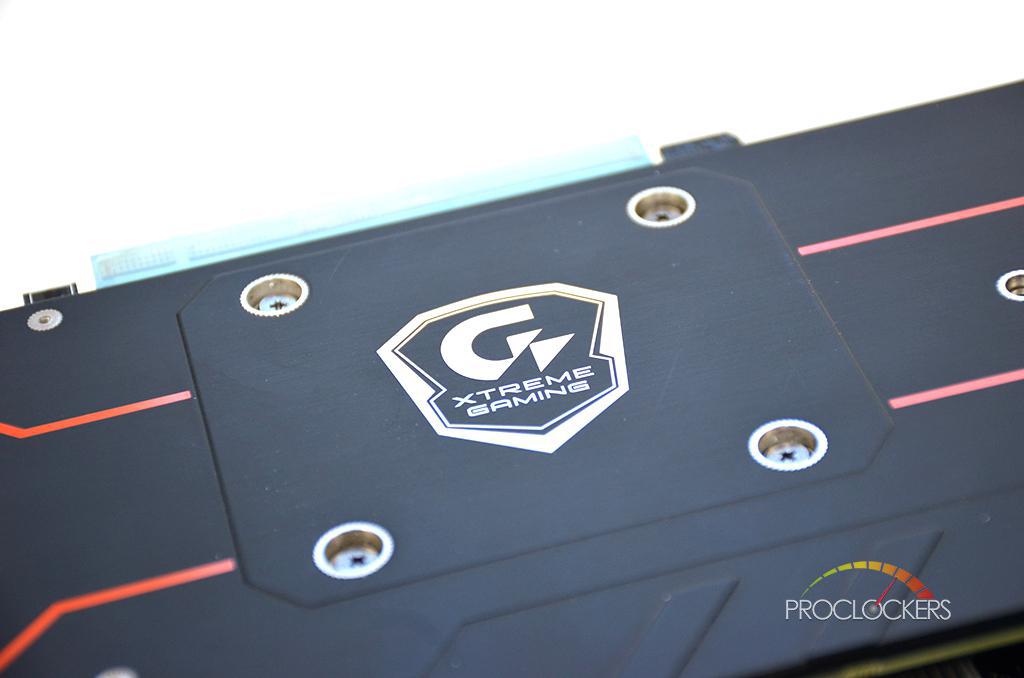
The back plate has the XTREME GAMING logo in the center of the back plate.
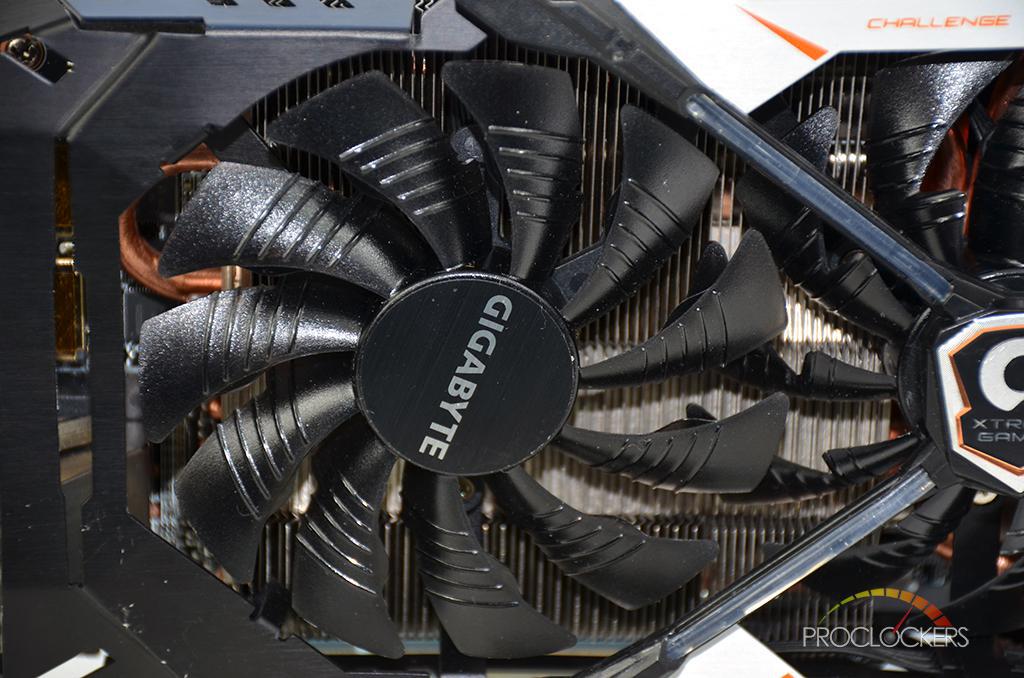
The channels on the fans blades allows for up to 23% more airflow.
Each fan has double ball bearings.
This dual bearing structure has better heat endurance and efficiency than a sleeve bearing structure.
This allows for a longer life span for these fans, and the card. Each of the fans have a triangular design on the edge of the blade.
This splits the airflow, which is then guided through the channels on the blade’s surface. This design increases airflow up to 23% over conventional fans.
The XTREME GAMING graphics cards are equipped with a 3D-Active Fan.
The fans will remain off when the GPU is under a set loading or temperature for low-power gaming.
There is a FAN STOP LED indicator on the side of the fan that tells you when the fan is supposed to be stopped.
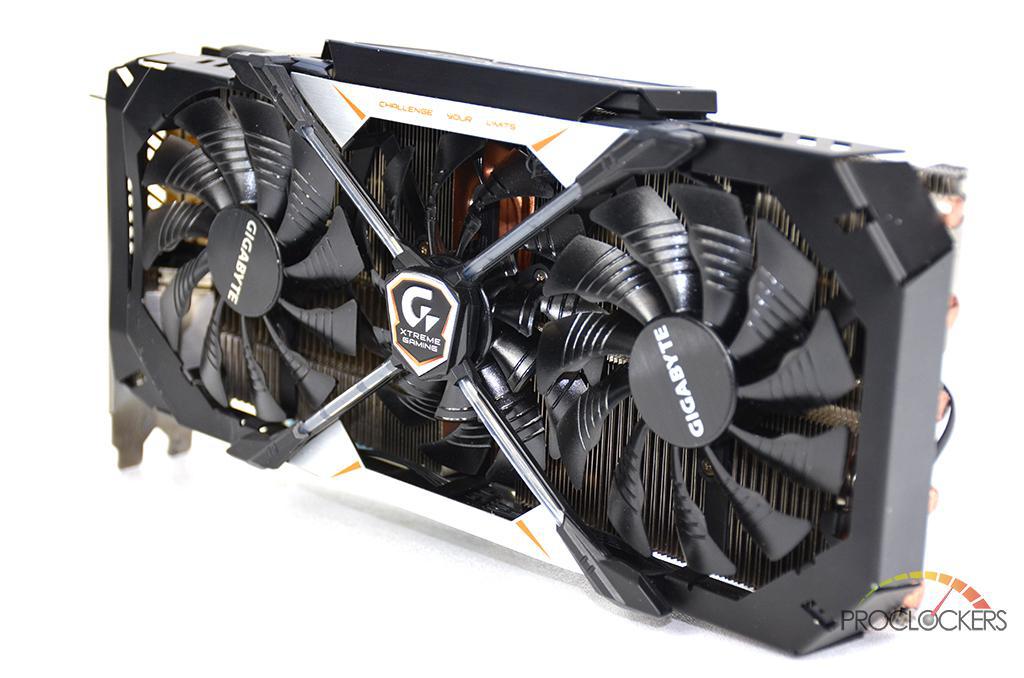
The middle fan spins in the reverse direction of the end fans, this allows for the Windforce cooler to better dissipate heat away from the card.
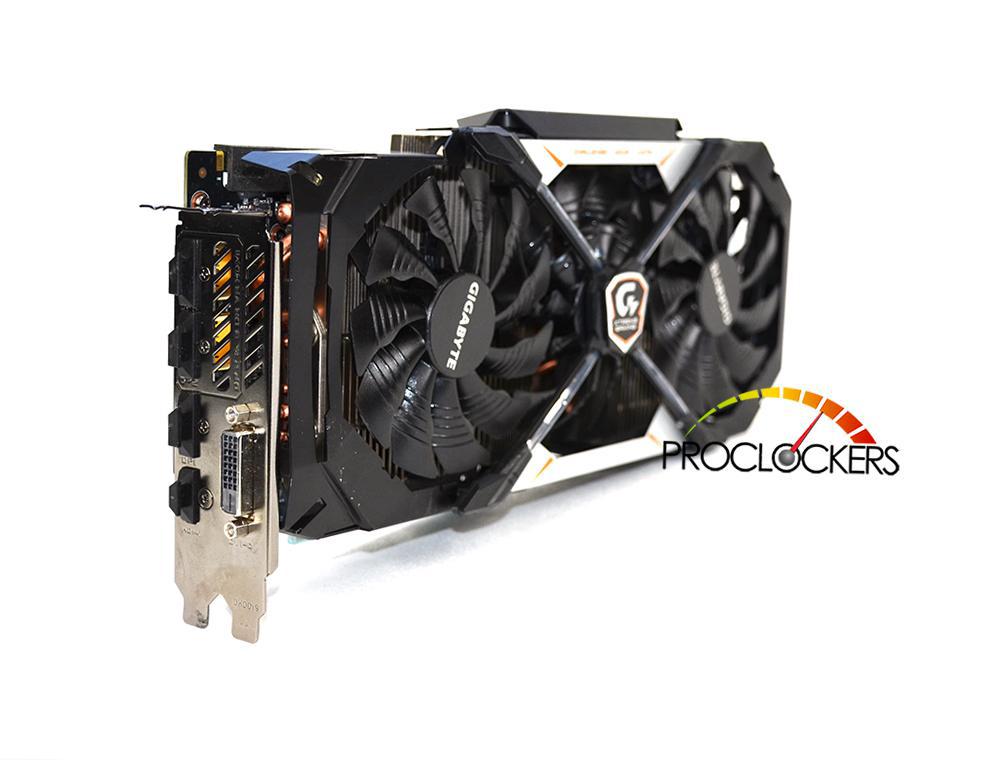
3 100mm stack fans fit into less than 300mm length area. This allows for a heavier concentration of air flow into a smaller area, dissipating more heat from the card.
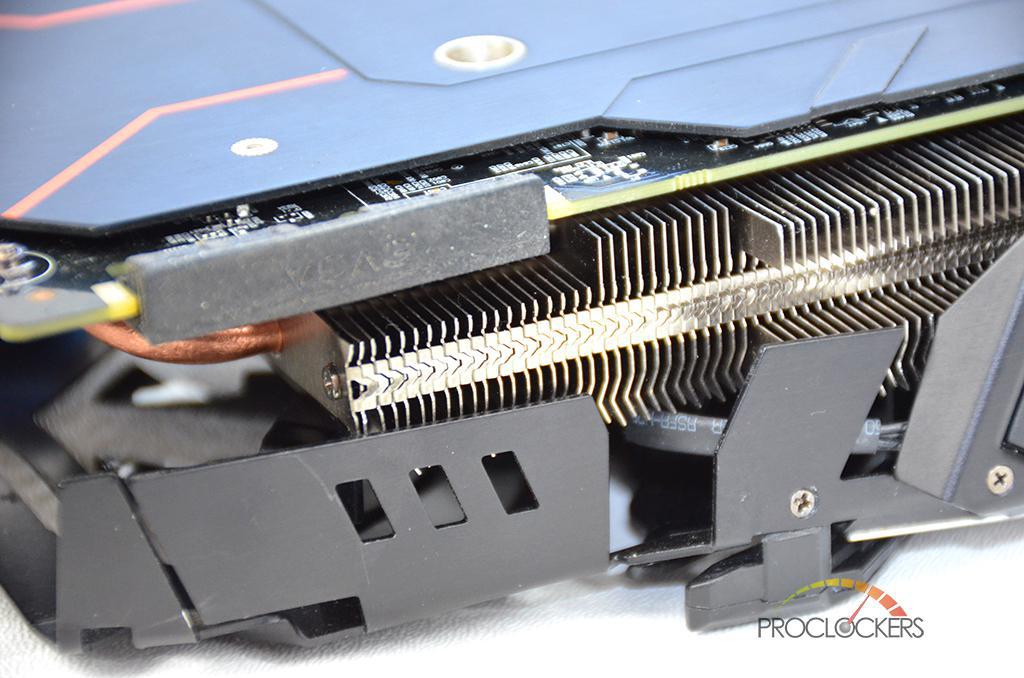
This picture shows the angled design on the fins on the fan side of the heat sink.
The angular design and unequal height of the fins not only help to channel air through the fins but gives the heatsink a larger surface area to dissipate heat.
Twisted through the heat sink is a series of 6 composite heat pipes.
The composite heat-pipes combine both thermal conductivity and phase transition, which increases 29% of cooling capacity.
These composite heat pipes are all connected to a very large, copper cold plate.
This cold plate makes direct contact with the GPU, as well as the card’s VRAM.
This helps keep the ram that much cooler, and potentially allows for a more stable, and higher overclock.
In theory, leading to better performance.
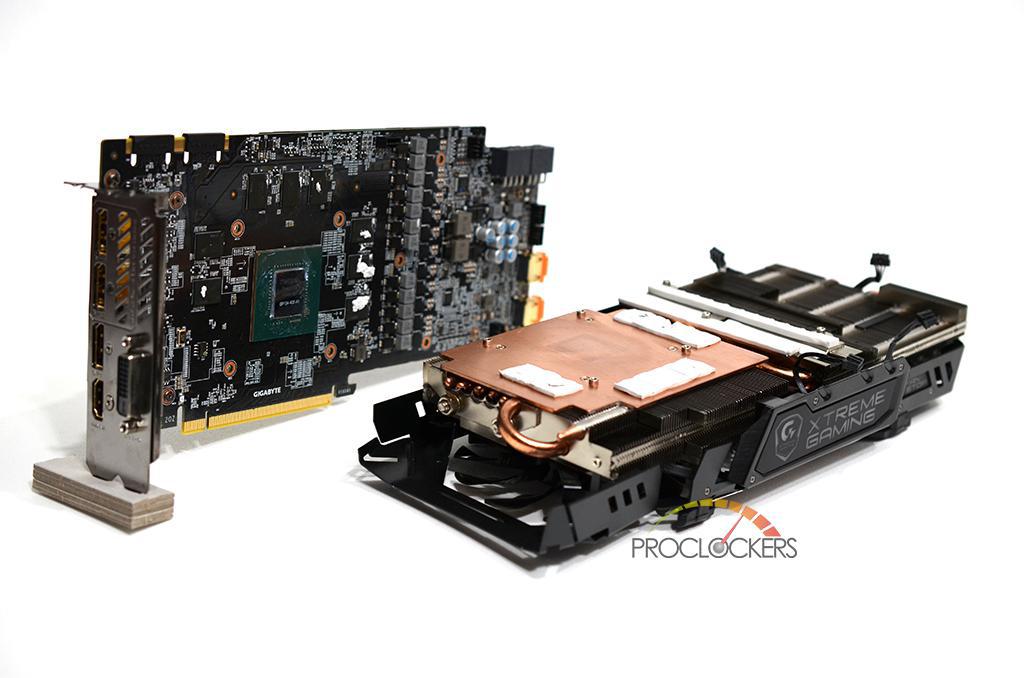
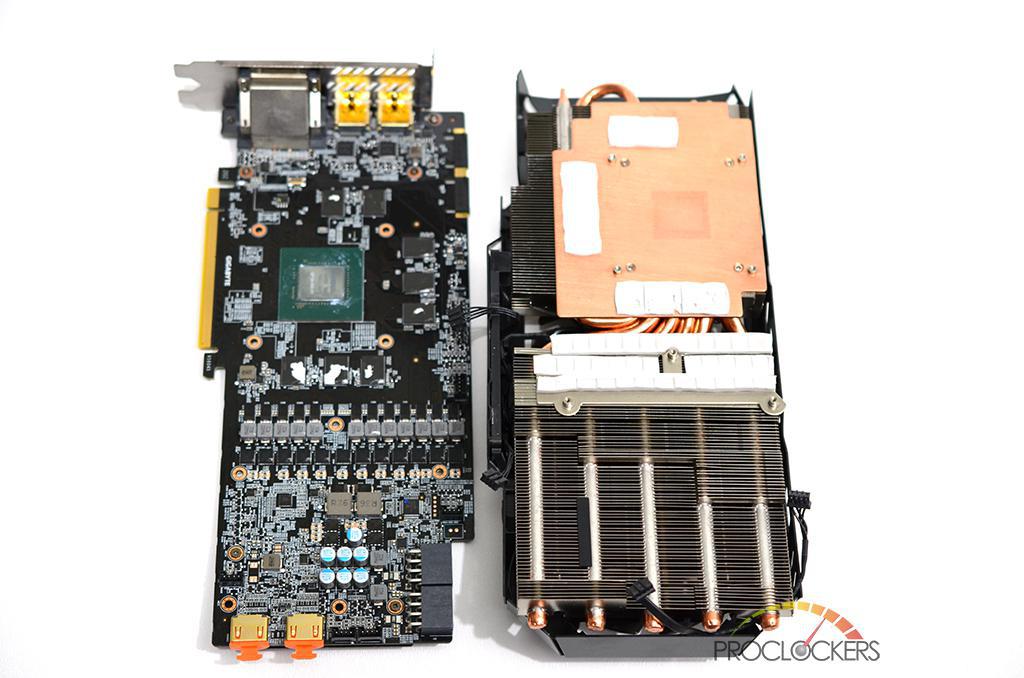
In these pictures, you can see the cooler removed from the card.
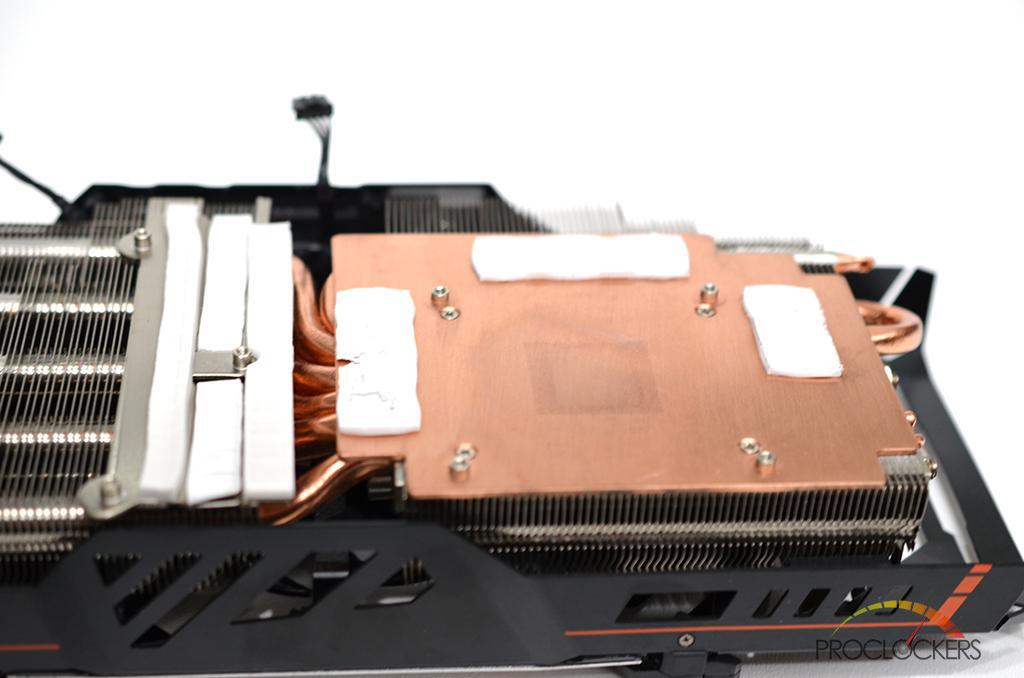
The cold plate is massive and has thermal pads over the VRAM and the power delivery.
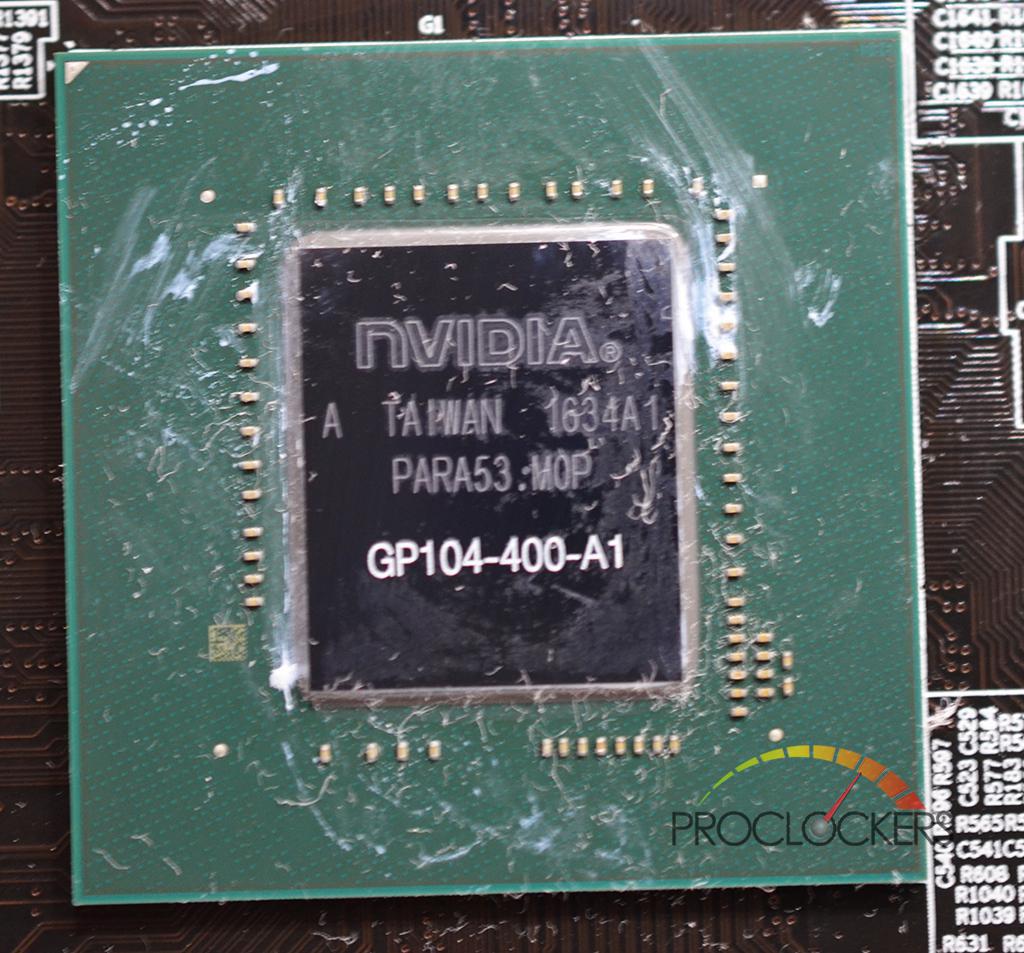
The XTREME GAMING 1080 has a GP-104 GPU.
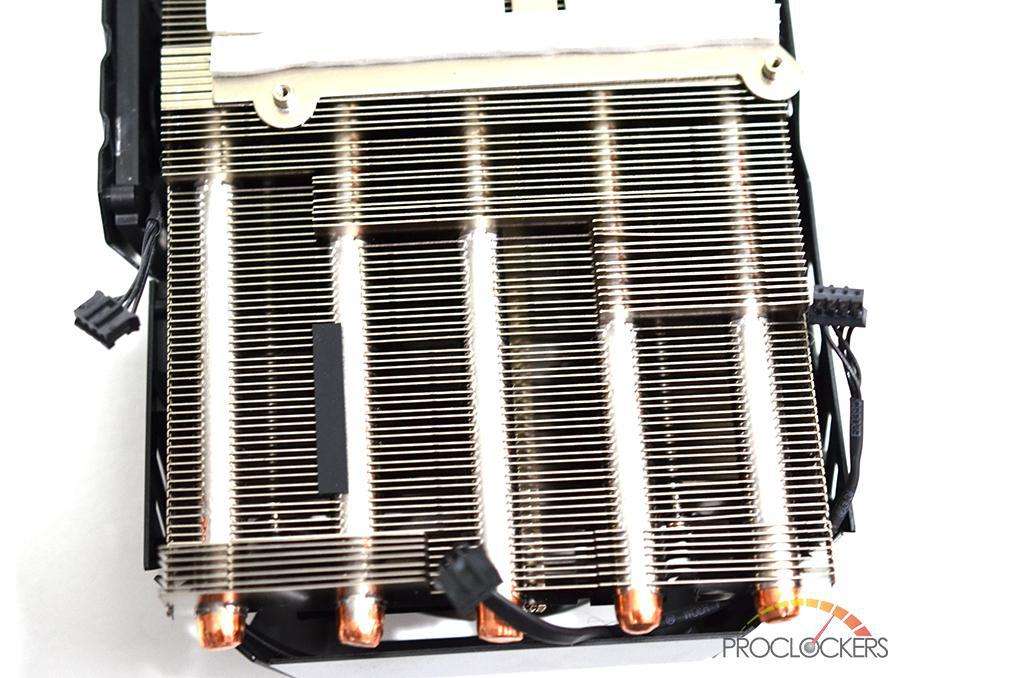
The composite heat pipes are spaces out evenly throughout the fin array.
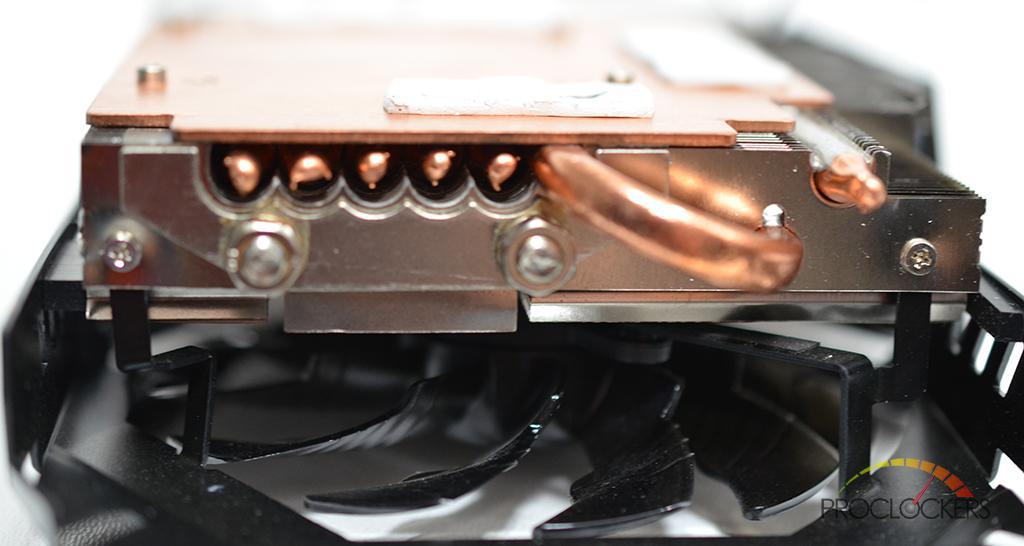
The heat pipes all meet up under the cold plate. This picture shows just how thick the cooler on this card is.
RGB Fusion
The RGB Fusion software can be downloaded from the GIGABYTE website.
This software can control the lighting on GIGABYTE motherboards, GPUs, and peripherals.
It can even control other RGB backlit peripherals, such as the G.Skill KM780R keyboard. There are two modes, basic and advanced.
Basic mode has 8 preset modes: Pulse, Music, Color Cycle, Static, Flash, Random, Wave and Intelligent.
In advanced mode, you can set each RGB zone to a different color and style.
Also in advanced mode, you can set the RGB lighting on any peripheral, cooler, case, RAM or any other RGB backlit item the RGB Fusion software supports.
Testing & Performance
CPU-Z
CPU-Z is used to validate CPU clock speeds. The 7700K that was used in testing was running at 5.0 GHz.
GPU-Z is also used to validate GPU Clock speed and voltage.
As in all benchmarks, I do my absolute best to keep all testing fair and as equal as possible.
The ambient temperature was a mild 22°C, or 72°F. The i7 7700K was run at 5.0 GHZ @ 1.40 volts. The GIGABYTE XTREME GAMING 1080 was kept at its stock sped, in OC mode, of 1784 MHz base clock, and 1936 boost clock, for all benchmarks.
The only exception being 3DMARK Time Spy and Firestrike.
Both of which were run at stock speeds and overclocked to as far as the XTREME GAMING ENGINE would allow it to go.
That being a +115 on the core, +5 on the voltage, +200 on the memory, +9°C on the temperature limit, and the power draw as high as it was allowed.
For the synthetic benchmarks, I tested OpenGL and DirectX 11. DX12 still hasn’t been widely adopted enough for there to be enough games to test it.
For the Gaming benchmarks, the games were run in 1920 x 1080p. 2560 x 1440p and 3840 x 2160p. I’ve also included 3440 x 1440p results in this review, and will from here on out.
We use only full release drivers and software, meaning no beta drivers as they are usually not 100% stable.
I used Windows 10 Professional due to it being the most recent operating system, as well as having DX 12 support.
All games were run on the highest possible settings, with no MSAA or AA of any kind in 4K results.
The GPU was set to its stock clocks.
ASIC Quality
The ASIC Quality of the XTREME GAMING 1080 tested in this review was 97.0%.
What exactly is ASIC Quality and how does it effect a GPU?
An application-specific integrated circuit, or ASIC, is a chip customized for a specific use.
For example, a GPU is a graphics processing unit. That’s why we equate ASIC quality with GPUs and not CPUs. CPUs are designed to do a wide range of tasks and GPUs handle graphics.
As the chips are produced, they are tested to ensure quality and assigned a rating.
The high-quality ASIC is one that achieves the highest clock speed while consuming the lowest amount of power and producing the least amount of heat. An ideal chip you might say.
So, what does this have to do with a GPU?
When applying ASIC quality to a GPU, you take into consideration power consumption and heat production.
With less power consumption and lower heat, in theory, comes a higher ASIC Quality.
This is where the binning process comes into play and why the higher-end GPUs like for example the EVGA Kingpin and the MSI lightning should end up with the higher binned, and therefore higher ASIC quality chips.
So, what’s a good ASIC score?
GPU-Z essentially says if you have a higher ASIC Quality, your card will overclock just fine on AIR, usually 70% +.
However, if you have a lower ASIC quality, 60% +, the card is better suited for other means of cooling, such as water or LN2. This is just how Techpowerup interprets ASIC Quality.
The GIGABYTE XTREME GAMING 1080 cards I used in this review have an ASIC Quality of 97.0%.
On a side note, it seems that GPU-Z wouldn’t give an ASIC reading on any card after version 0.8.7. Now, after all that, there must be a disclaimer.
At least for Pascal, several people have said they have gotten inconsistent ASIC readings from the same card, on different systems.
Some cards, do not even give an ASIC quality at all. So, take this reading with a grain of salt.
Cinebench
Cinebench is a synthetic benchmark that evaluates your computer’s performance capabilities.
It’s based on MAXON’s animation software Cinema 4D, which is used by studios and production houses worldwide for 3D content creation. I ran all aspects of Cinebench.
First was their OpenGL GPU test in which the MSI GTX 1070 GAMING 8G scored 143.57 fps.
The second was the CPU test. This test maxes the CPU to 100% and tests its rendering capability.
My i7 7700K scored an impressive 1036 CB on this run, with a single-core performance of 211 cb. This is one of the better overall and single-thread scores I’ve ever achieved with a quad-core with hyperthreading.
As for the OpenGL benchmark, the XTREME GAMING 1080 achieved 150.75 frames per second. This test throws me off a bit, as usual.
Seeing how the last card I tested, the Red Devil RX 470 scored 180.30 FPS. I’m just not sure how these results are achieved.
It does seem that the OpenGL test favors AMD graphics cards though.
Unigine Heaven
The Heaven Benchmark is a DirectX 11 benchmark designed to stress your GPU under heavy loads.
The Heaven Benchmark can be used to determine the stability of a GPU under extremely stressful conditions.
I ran the heaven benchmark with the ASUS STRIX GTX 1070 on a custom Preset, Ultra Quality, Extreme Tessellation, AA X8, in 1080p using the DX 11 API.
With these settings, the XTREME GAMING 1080 received an overall score of 2962 with an average FPS of 117.6, a minimum of 42.5 and a maximum of 250.8.
Gaming Results
Games
- Battlefield 1
- Crysis 3
- Grand Theft Auto V
- Rise of the Tomb Raider
- Shadow of Mordor
- Thief
- Watch Dogs 2
- The Witcher 3
I tested the usual games I test, and I added a new title, Battlefield 1.
Having been released in October 1026, Battlefield 1 had DX12 support and is a beautiful game. The rest of the games are a mix of older and newer titles, with no games older than 2013.
Crysis 3 is the oldest of the titles.
However, it’s still one of the most graphically demanding games on the market. Grand Theft Auto V didn’t hit PC until 2015 and has one of the most extensive graphics menus I’ve ever seen.
Shadow of Mordor is a 2014 title, but still, a very demanding game, especially with the 4K texture pack is installed. Thief is another 2014 title, but it’s still a beautiful and rather demanding game.
I’ve replaced the Tomb Raider reboot with its sequel, Rise of the Tomb Raider. Also, the Witcher 3 and Watch Dogs 2 were also tested.
They were benchmarked in 1080p, 1440p, 4K, and with my recent purchase of an ultra-wide, will start benchmarking games in 3440 x 1440p.
All games were played at their max settings with 4x MSAA.
Each benchmark run was timed at 120 seconds, ran 3 times each, and averaged out to get the overall results.
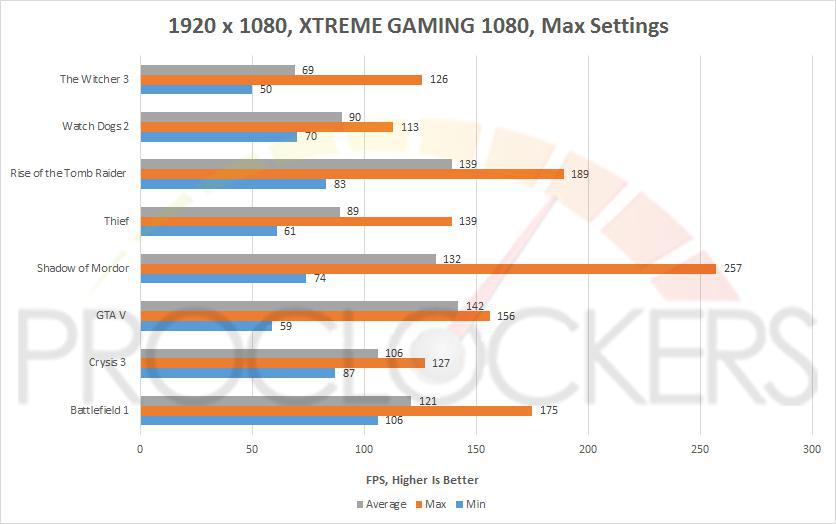
Even with all settings maxed out, the XTREME GAMING 1080 is overkill at 1080p. Even The Witcher 3 averaged well over 60 FPS.
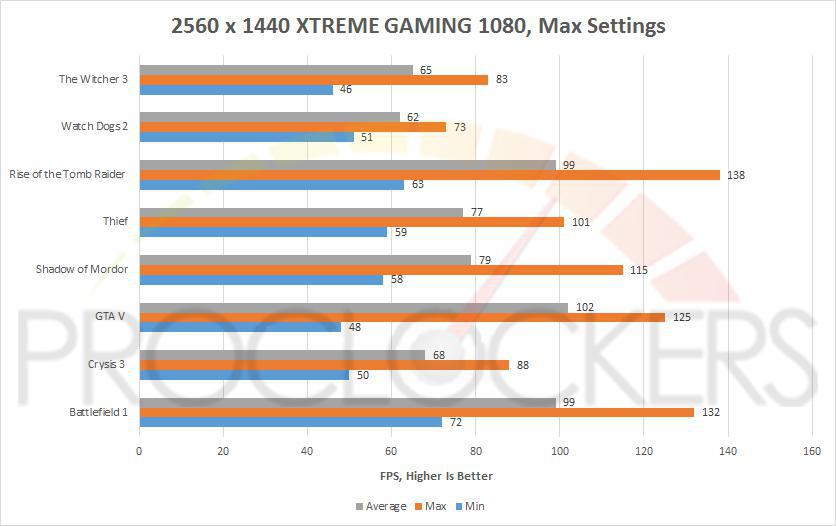
In 1440p, every game tested averaged over 60 FPS with max settings, with GTA V doing best with an average of 102 FPS.
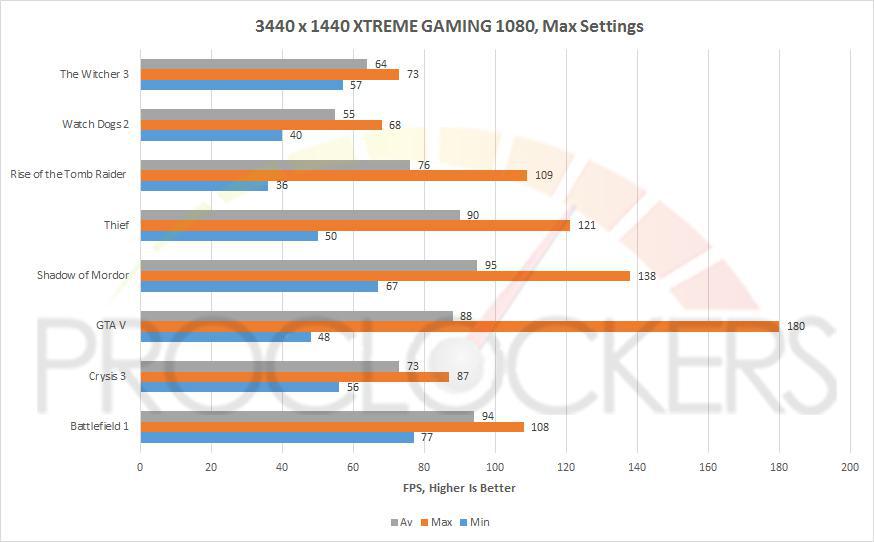
I was very happy with the results with the Ultra Wide in 3440 x 1440. All games stayed above 60 FPS with one exception, Watch Dogs 2, which averaged 55 FPS.
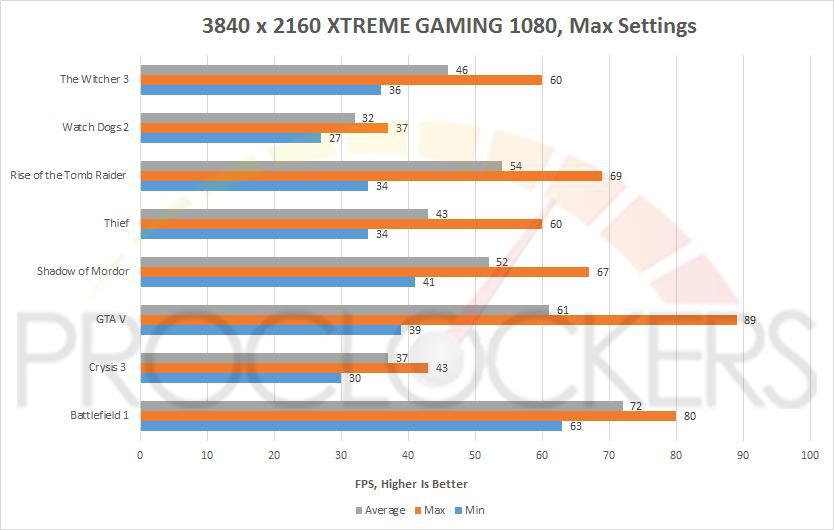
When I test games in 4K, I hope for an average above 30 FPS. All games achieved this with GTA V and Battlefield 1 even averaging above 60 FPS.
Overclocking & Temperatures
Max temperature on the XTREME GAMING 1080 was 71°C.
As far as overclocking, I used the XTREME GAMING ENGINE for GIGABYTE to tweak the GPU, and I used Hardware Monitor for monitoring the temperature.
The XTREME GAMING 1080 comes set in Gaming Mode out of the box. In this mode, it has a base clock of 1759 MHz and a boost clock of 1898.
However, using the Xtreme Gaming Engine, you can switch to OC mode. This gives you a base clock of 1784 MHz and a boost clock of 1936.
This is the setting we used in testing.
The Xtreme Gaming Engine also allows you to set custom fan curves, as well as change the RGB lighting on your graphics card.
On the first screen, you’ll see any GIGABYTE hardware or peripheral that is supported by the Xtreme Gaming Engine.
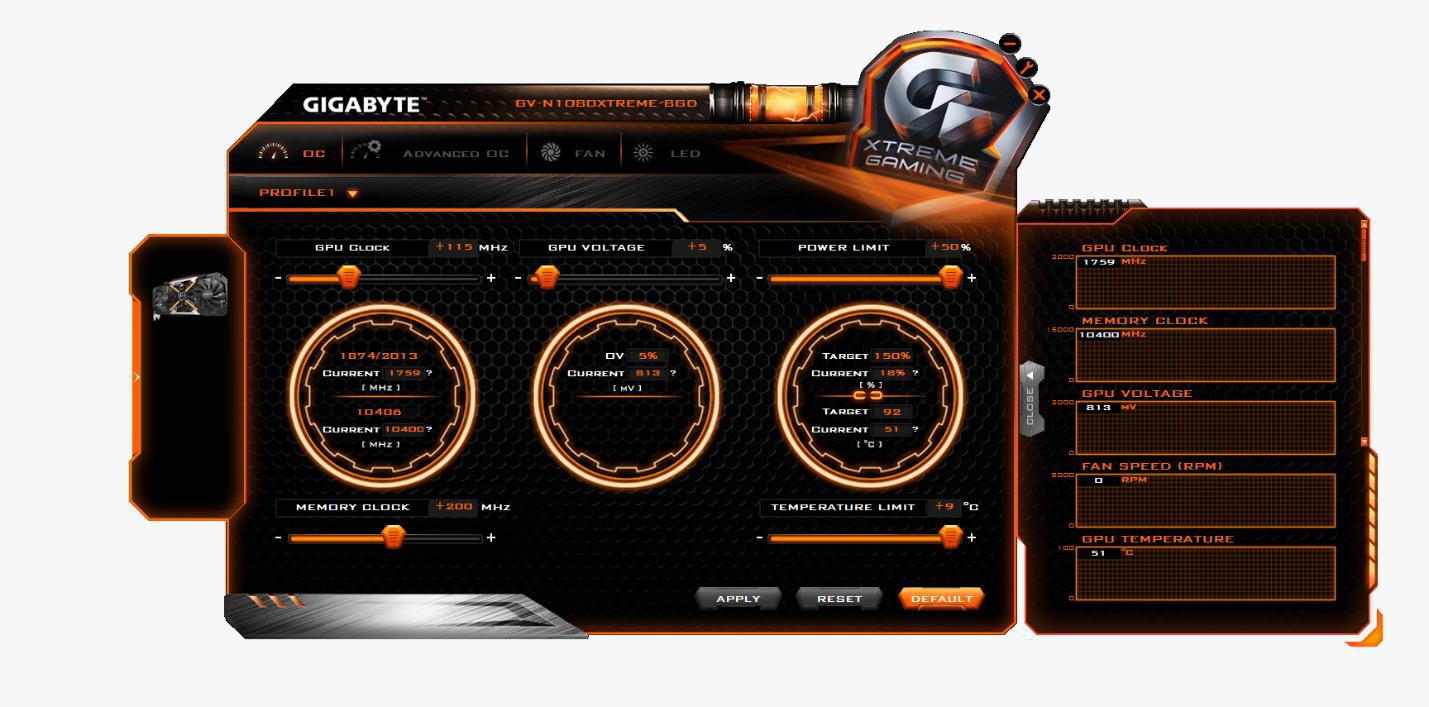
Once the card is selected, you come to the basic OC menu. Here you can adjust the core clock, memory clock, power limit, voltage, and temperature limit.
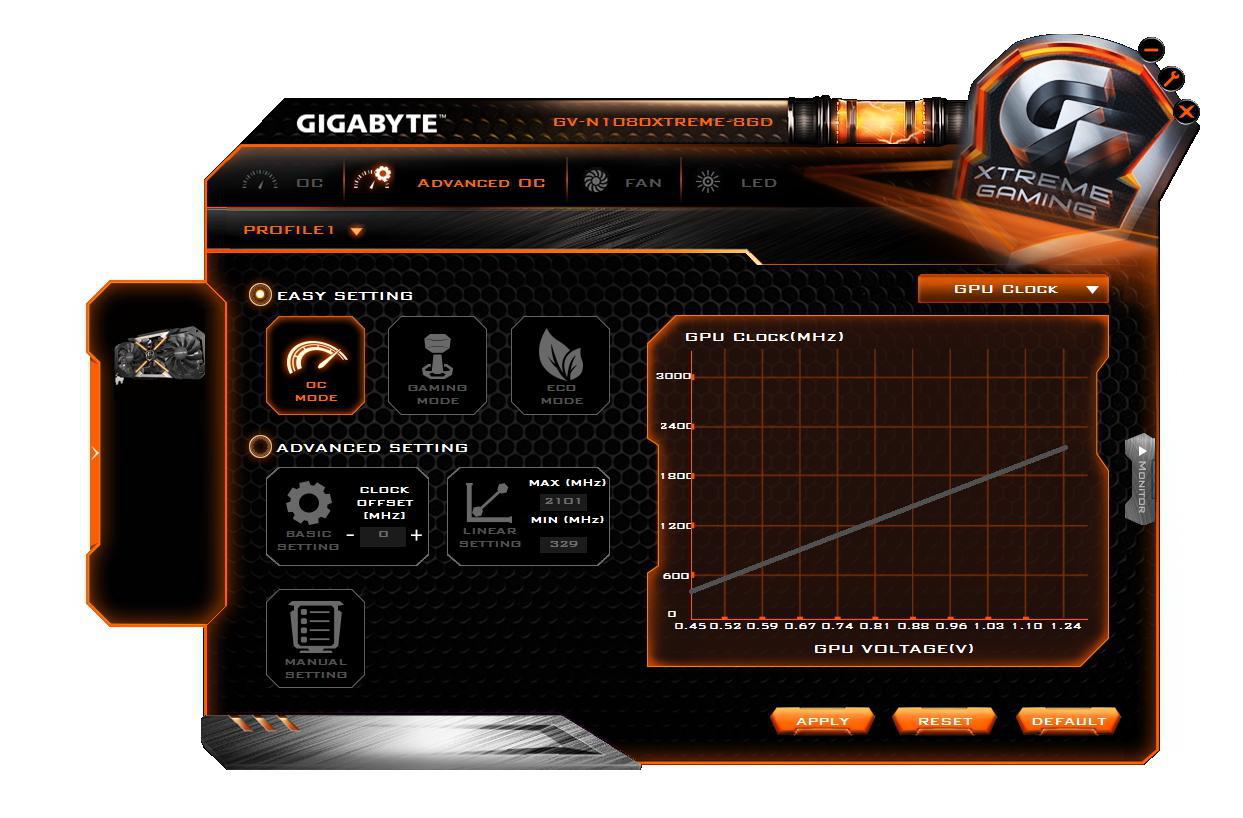
In the Advanced OC menu, you have easy settings. These set you base and boost clock to a preset amount. There are Eco Mode, OC Mode and Gaming Mode. In the advanced menu, you can set a min and max MHz, the clock offset, or manually set everything.
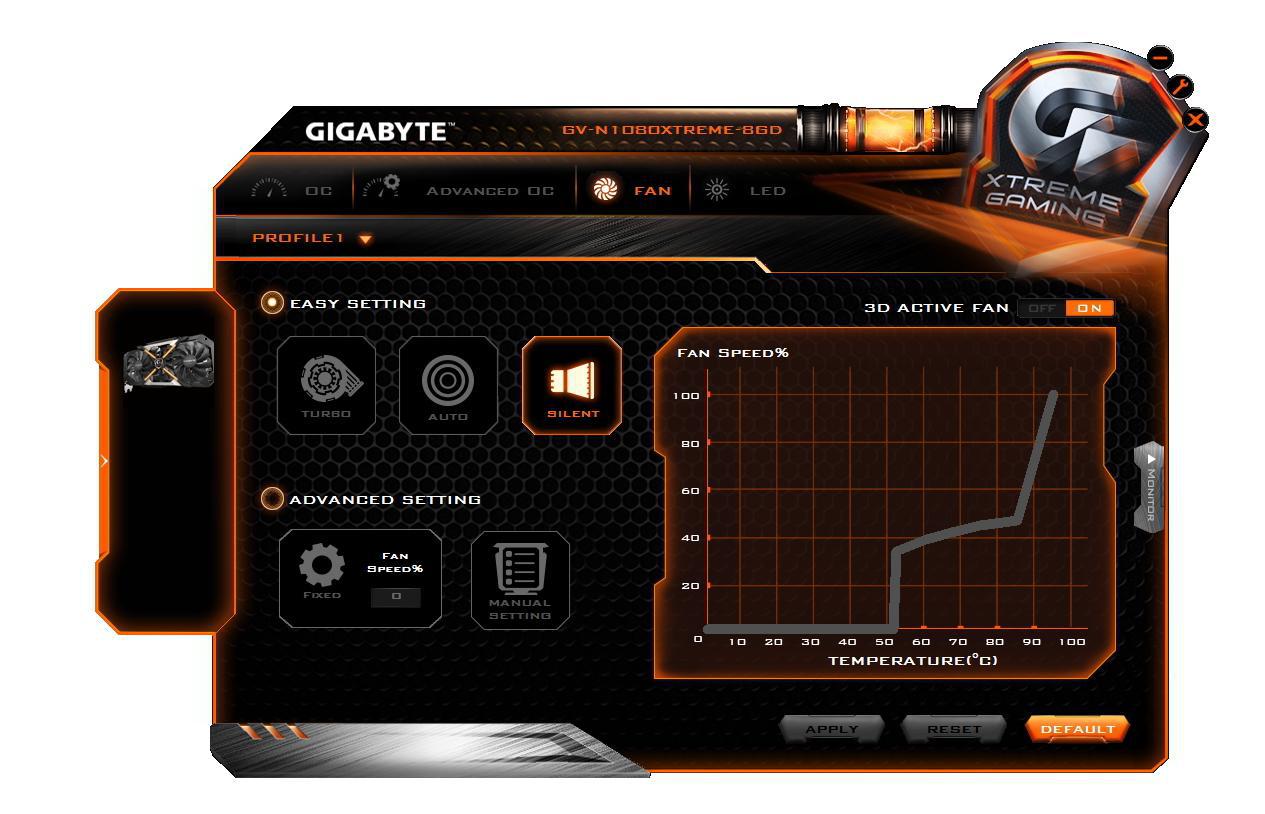
In the fan section, you can set custom fan curves.
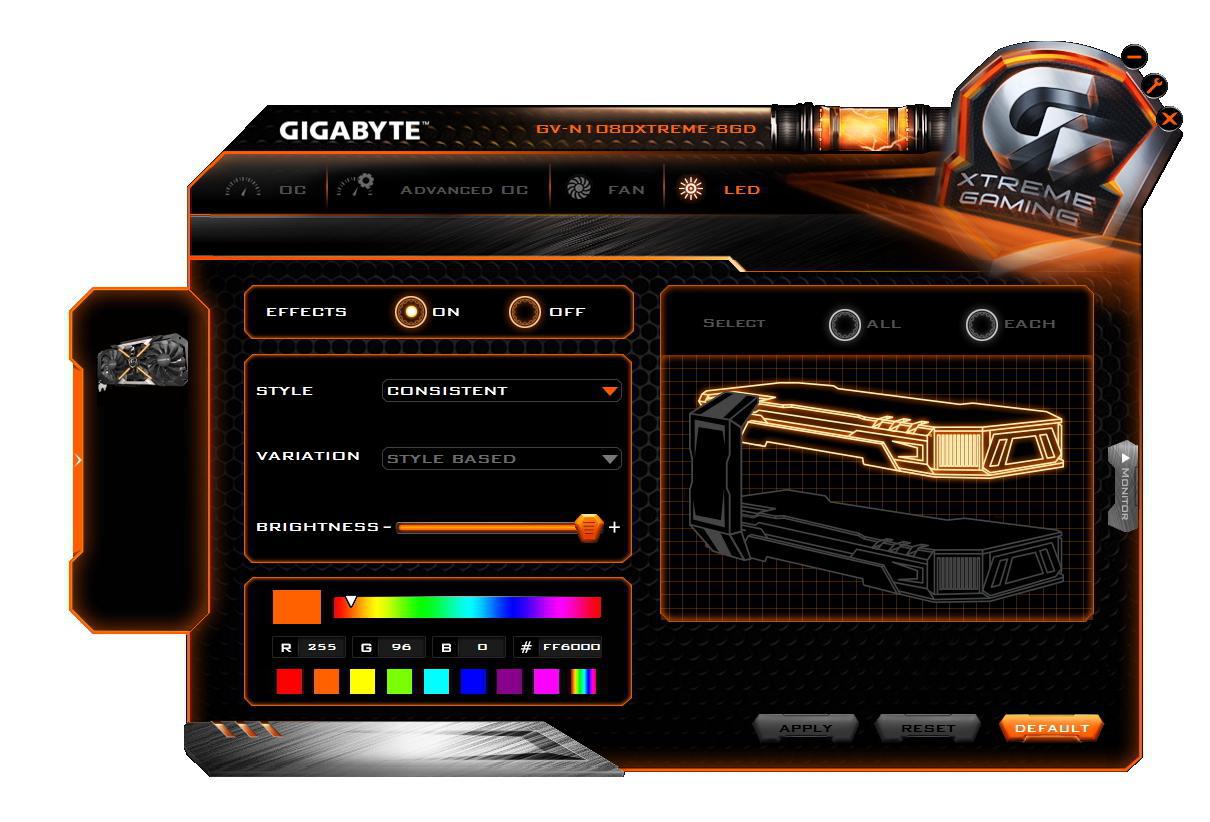
The lighting setting allows you to customize the RGB settings of the card.
3DMARK

3DMark is a computer benchmarking tool created and developed by Futuremark used to determine the performance of a computer’s 3D graphic rendering and CPU workload processing capabilities.
It does this through a series of graphics and physics and or CPU tests.
I used 3DMark’s most popular benchmark, Firestrike as well as their newest DX12 benchmark, Time Spy to test the ROG STRIX 1070.
I tested at both stock and overclocked to +91 on the core and +250 on the memory.
I ran both Firestrike and the new DX12 benchmark, Time Spy.
The XTREME GAMING 1080 was set in OC mode through the Xtreme Gaming Engine. The base clock was 1784 and the boost clock is set to 1936 MHz in OC mode.
The card comes factory set to Gaming Mode with a base clock of 1759 and a boost clock of 1898. Even from its base clock of 1784 in OC mode, the XTREME GAMING 1080 was boosting over 2000 MHz, hitting 2025 MHz.
When overclocked to +115 on the core, +200 on the memory, and a 5% increase in voltage, the XTREME GAMING 1080 hit a max frequency of 2165MHz.
Of all the Pascal cards I’ve tested, that’s only second to one of my Founders Edition 1080’s at 2178 MHz.
The ambient temperature was about 22°C or 72°F in my office at the time of testing. This is warmer than I prefer, but still rather comfortable.
The XTREME GAMING 1080 ran relatively cool, maxing out at 71°C, and in-game, it stayed around 62°C. I was also pleased with the noise levels.
Since the fans don’t even spin until the GPU hits 67°C. the card makes no noise while idle.
Just the noise my test bench itself makes about 35 decibels.
While benchmarking, it ran around 45 decibels. However, in gaming, it was very quiet, usually around 40 or so decibels.
In games that aren’t graphically demanding, like rocket league and shovel knight, the fans only spun every so often, for 30-60 seconds.
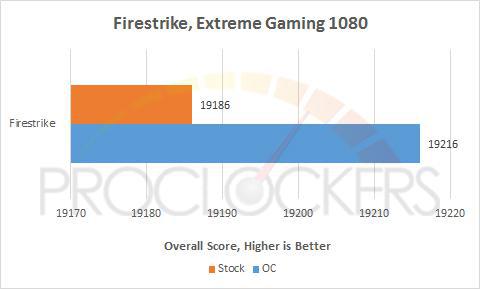
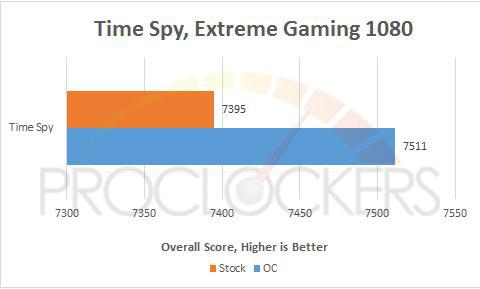
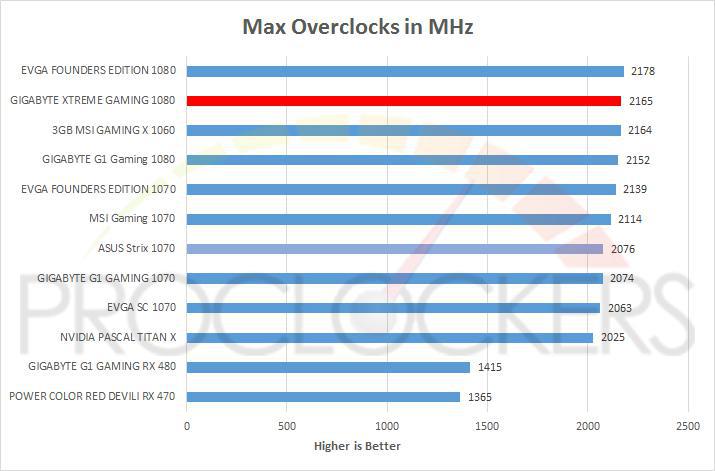
Of all the cards I’ve personally tested, the XTREME GAMING 1080 hit the second highest overclock, 2165 MHZ. Second only to a Founders Edition.
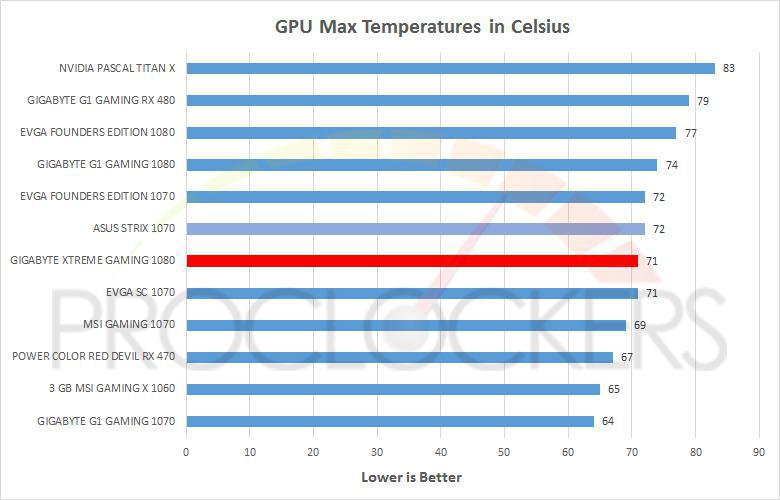
For this card being a 1080, it ran very cool. It was the coolest of all the 1080s I’ve tested.
Final Thoughts & Conclusion
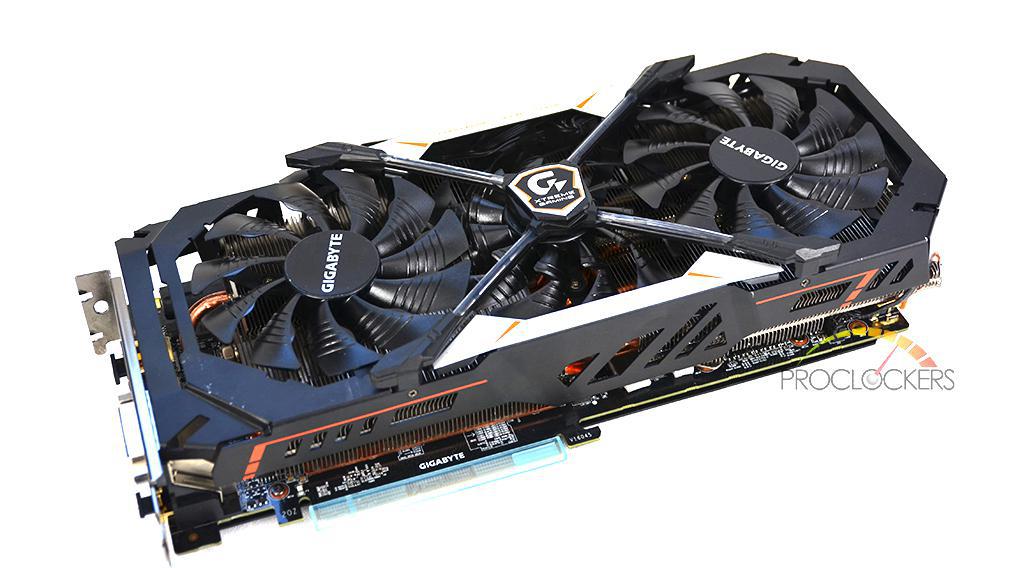
It is apparent to me that the XTREME GAMING GTX 1080 from GIGABYTE lives up to its name.
It’s a beautiful card with a massive and very efficient cooler. This provided exceptional performance in all areas.
With the addition of the VR link offered with this premium package, this is the ultimate card for a system designed for VR.
I’m very happy to see that, unlike some of their competitors, they didn’t sacrifice a DisplayPort to make the card VR ready.
This means the card can be set up for VR, and you can still take advantage of NVIDIA Surround with all 3 DisplayPort.
I knew the XTREME GAMING 1080 would perform well. What I hadn’t expected was for it to outperform all other GTX 1080’s that I’ve ever tested.
It clocked higher (2165 MHz) than any other Pascal card I’ve tested, except for one of the Founders Edition 1080’s I had. It was also the coolest running 1080 I’ve ever tested, with a max temp of only 71°C.
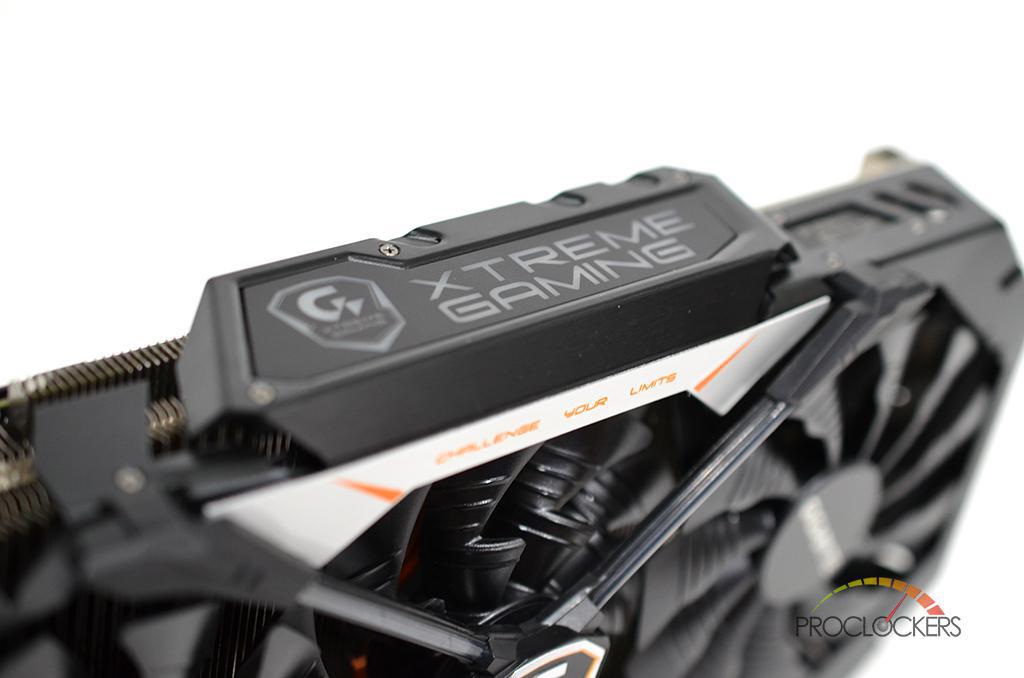
The performance of this card is only matched by its beauty.
The 3 x 100mm stacked fan design not only looks great but helps keep the card cool and boost very high.
In OC mode, from its stock clock of 1784, this card was boosted to 2025 MHz with GPU Boost 3.0. That’s great! I also think that GIGABYTE did the RGB lighting on this card right. It’s not overwhelming at all.
With RGB lighting on the side and over the center fan.
There’s just so much I like about this card, especially the price. With the recent release of the 1080 ti, the Premium Pack XTREME GAMING 1080 dropped by $100 USD.
It now sells on both Newegg and Amazon for $549.99. With the combination of price and performance, I’m very happy to award the Xtreme Gaming GTX 1080 from GIGABYTE the Proclockers “Elite Hardware” award.
This card will take anything you can throw at it and more.
Whether you’re into VR, video editing, or simply gaming, this card can do it all.
What did you think of our Gigabyte GeForce GTX 1080 Xtreme Gaming GPU review? Leave a comment below.






